Affiliate links on Android Authority may earn us a commission. Learn more.
OnePlus phones: A history of the company's entire lineup so far
Published onMarch 8, 2024
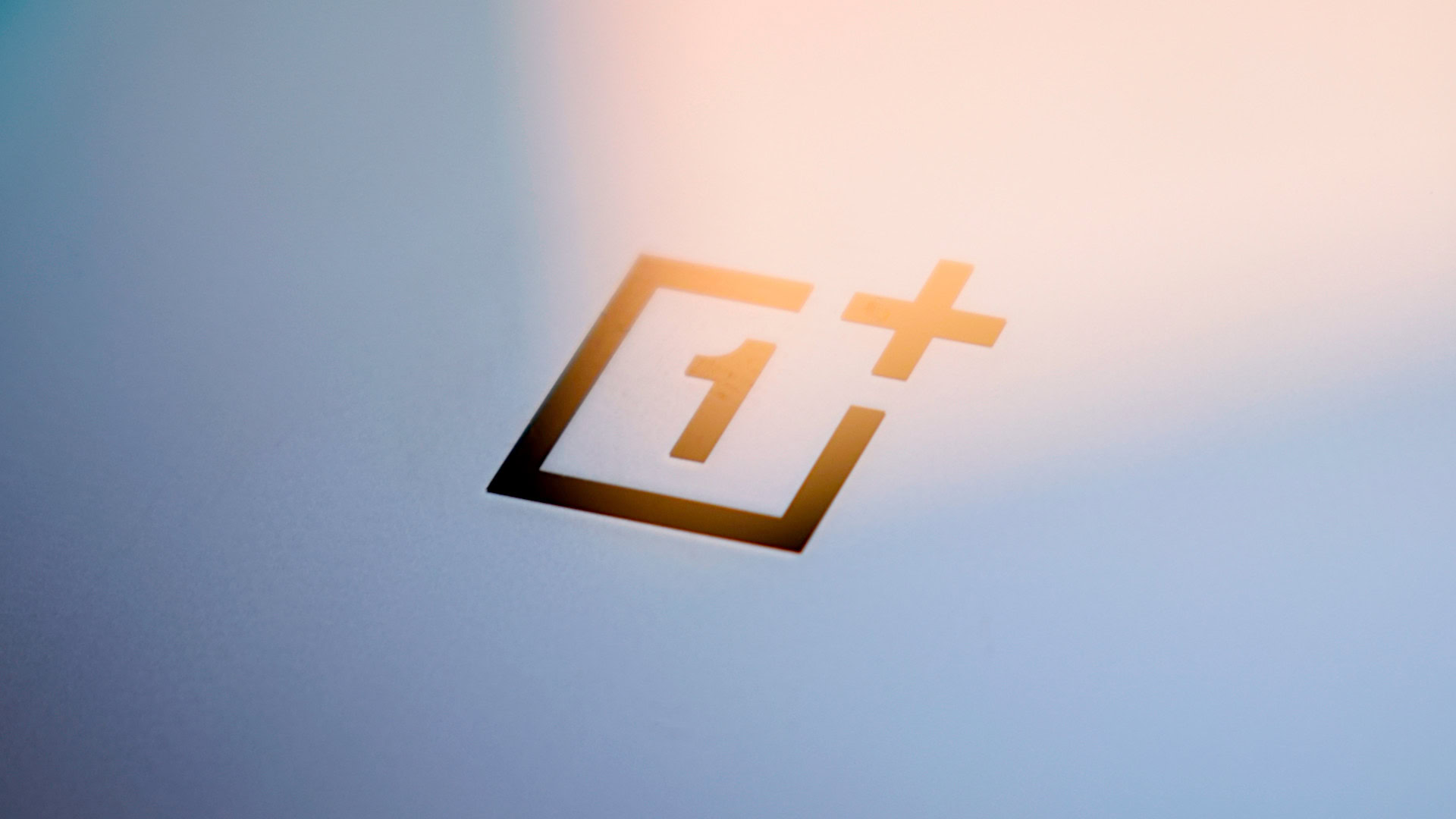
In late 2013, two former OPPO employees started a new smartphone brand called OnePlus. Their vision was to make OnePlus phones the devices that ticked off every box Android fans needed. Everyone wanted a great design, powerful specs, the fastest and leanest software, and a low price. The dream became a reality in 2014 with the launch of the OnePlus One.
Since then, OnePlus has moved from its humble beginnings as an online-only niche smartphone maker to a literal global powerhouse. It’s quite an achievement when you look back and realize it’s been just 10 years.
This article will lay out a thorough history of each significant OnePlus device. From the OnePlus One to the OnePlus 10T, they are all here.
Editor’s note: We’ll be sticking to the core OnePlus phones to keep things concise. Some of the company’s devices have subtle variants that aren’t unique enough to spend too much time on.
OnePlus One: The OG
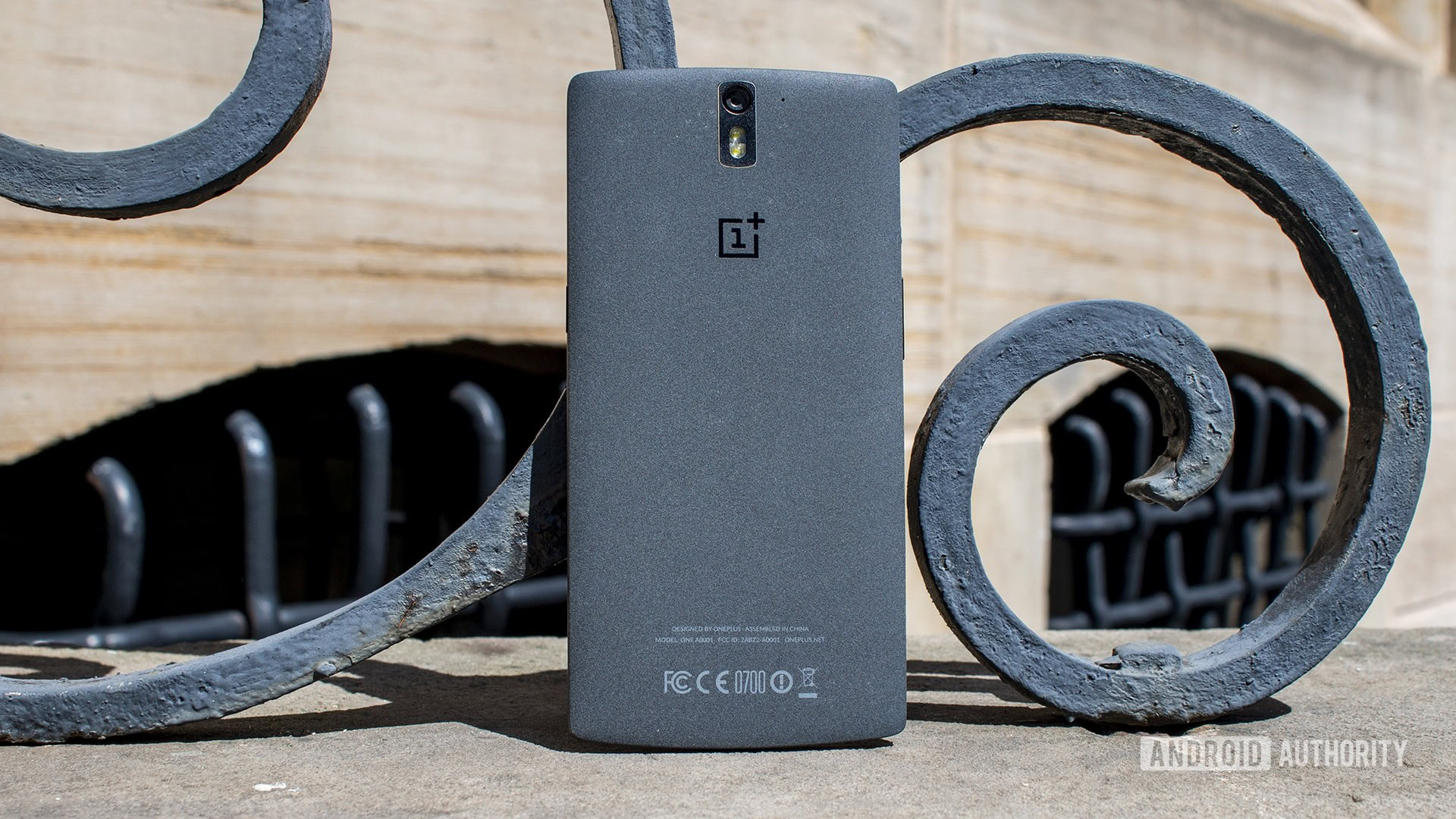
It wouldn’t be surprising if every smartphone brand that’s started since 2014 has brought up the OnePlus One at meetings as an example of what they want to do. You couldn’t ask for a more successful launching pad for a brand. Simply put, all future OnePlus phones will be forever compared to this one.
All in all, the One wasn’t too different from other Android phones of its time. However, it had a few things that set it apart. The first is the software, which was, at launch, the Android-based Cyanogen OS, which forked off from the popular custom ROM known as CyanogenMod (now known as Lineage OS). Cyanogen OS was lean and developer-friendly, making it appealing to both Android tinkerers as well as general users who appreciate a bloat-free experience.
Another unique aspect of the One was the price. The phone started at just $300, which was incredibly cheap when you factor in that it came with the latest Snapdragon 800 series processor of its time. When you combined that with the stunning design of the device (that Sandstone back!), you had a 2014 Android enthusiast’s dream machine.
When the One first launched, OnePlus took the unorthodox route of selling it via an invite system. You needed a unique one-time-use invite code to buy the phone — which could only be purchased online. The company seeded out a small batch of original codes to prominent members of its then-small community. After buying the One with those codes, those people would then get a new invite code they could share. Those invite codes would then turn into a new invite code, and on it would go.
While this left many early fans frustrated, it had two incredibly positive effects for OnePlus. It helped balance supply and demand for the very young company, as well as build buzz for the device. The invite code system ensured that if you owned a OnePlus One, you were “somebody.”
Although exact sales numbers for the OnePlus One are hard to come by, the company did divulge that it had sold over a million OnePlus phones by the end of 2014. This is pretty remarkable when you learn that OnePlus only anticipated selling 50,000 units of the One.
OnePlus One fast facts:
- The OnePlus One launched with Android 4.4.2 KitKat, and its final official update was Android 5.1.1 Lollipop.
- Although the One launched with Cyanogen OS as its Android skin, problems with Cyanogen, Inc. forced OnePlus to cease ties and create its own skin. Thus, Oxygen OS was born, making the OnePlus One a unique device that had two different official skins from entirely different sources during its lifetime.
- At various times, OnePlus put the One up for sale without requiring an invite code. For example, the company temporarily lifted the invite system for the 2014 iteration of Black Friday.
- Since the company started in December 2013 and released its first phone only a few months later, it was assumed that OPPO supplied OnePlus with resources to help it along. However, OnePlus continually denied that it was a subsidiary of OPPO. Of course, that’s not the case anymore.
- In 2014, the phone price started at $300.
OnePlus 2: The sophomore slump
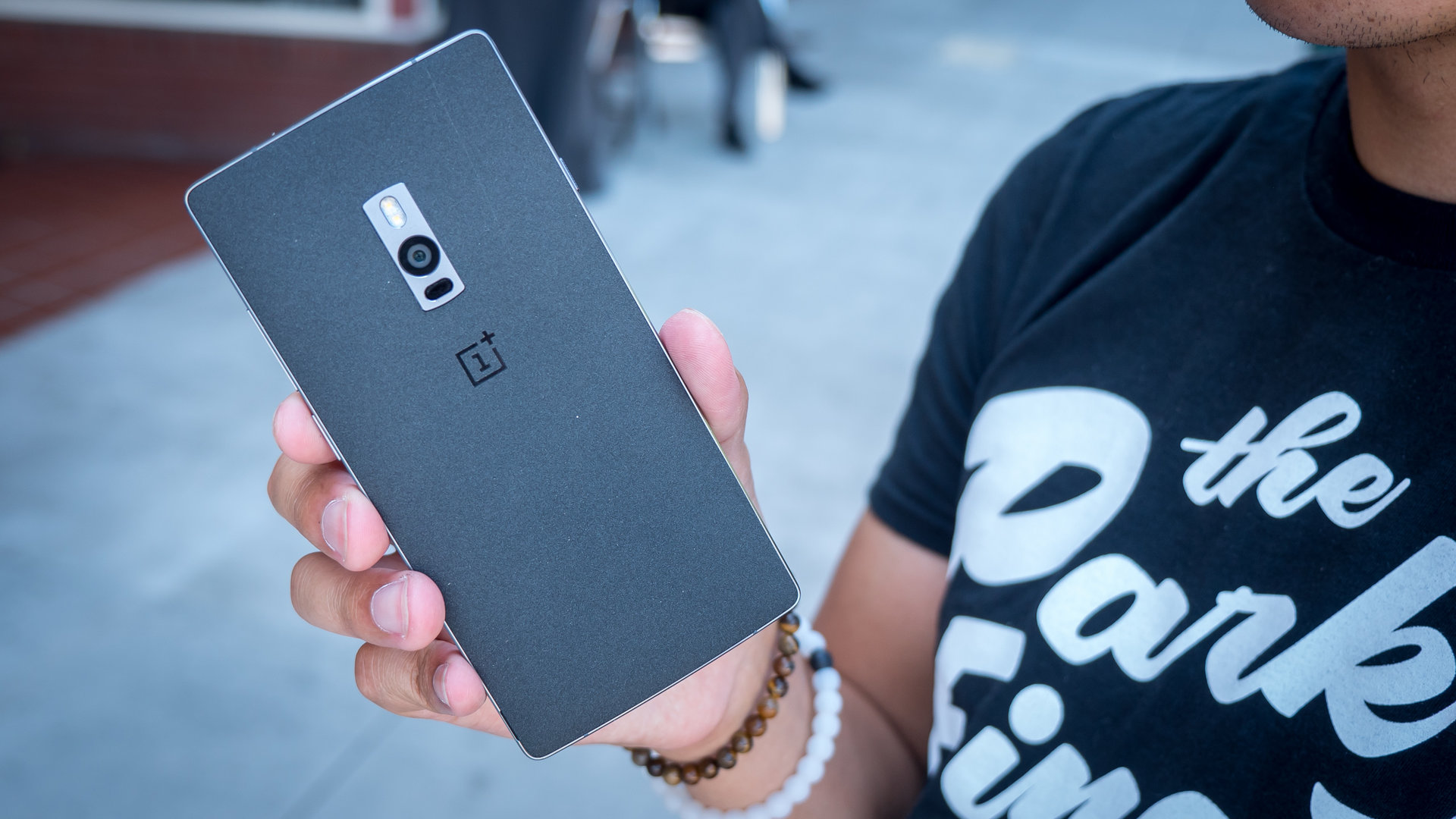
By the end of 2014, OnePlus found itself with a problem: it had gotten too big, too fast. Now, this is a problem most companies would love to have, no doubt, but it was still a problem. It was likely at least partially why the OnePlus 2, launched in July 2015, is generally regarded as the weakest of all the OnePlus phones.
Since the company didn’t expect to push over a million units of the OnePlus One, it likely didn’t expect a ton of media and industry scrutiny on its follow-up. Thus, the OnePlus 2 is essentially a subtly updated version of the OnePlus One, complete with the Sandstone back and similar body shape.
The OnePlus 2 may be the weakest of all the OnePlus phones.
As one would expect, the OnePlus 2 came with the usual upgrades. These included the newest Snapdragon 800-series processor, a bigger battery, a better display, higher-grade cameras, a fingerprint sensor, more speakers, etc. However, the base model didn’t come with more RAM or more internal storage and removed NFC support. To top it all off, the entry price for the phone went up to $330.
OnePlus also kept the invite system for the launch of the OnePlus 2, which this time backfired. Since many early adopters had only just gotten their hands on the OnePlus One after a long wait, they had no intention of going through the invite troubles again for the newer OnePlus phone.
Still, this didn’t stop the OnePlus 2 from selling well. By August 2015, the company admitted it had received over two million reservations for the device. Even if only half of those reservations turned into sales (which is very likely), the OnePlus 2 probably outsold the OnePlus One.
Regardless, the company did learn it needed to change up the game if it was going to continue to grow.
OnePlus 2 fast facts:
- The OnePlus 2 launched with Android 5.1.1 Lollipop, and its final official update was Android 6.0.1 Marshmallow.
- OnePlus, at one point, promised it would deliver an update to the OnePlus 2 that would bring it Android 7 Nougat. However, it did not keep that promise.
- The OnePlus 2 is the first of the OnePlus phones to have a physical alert slider. This popular feature has been on every single OnePlus flagship since.
- The codename for the OnePlus One was “bacon,” while the codename for the OnePlus 2 was much less creative: “oneplus2.” The following few OnePlus phones would go on to have boring codenames until the OnePlus 5 brought back the food-related monikers with “cheeseburger.”
- In 2015, the price of the phone started at $330.
OnePlus X: The experiment
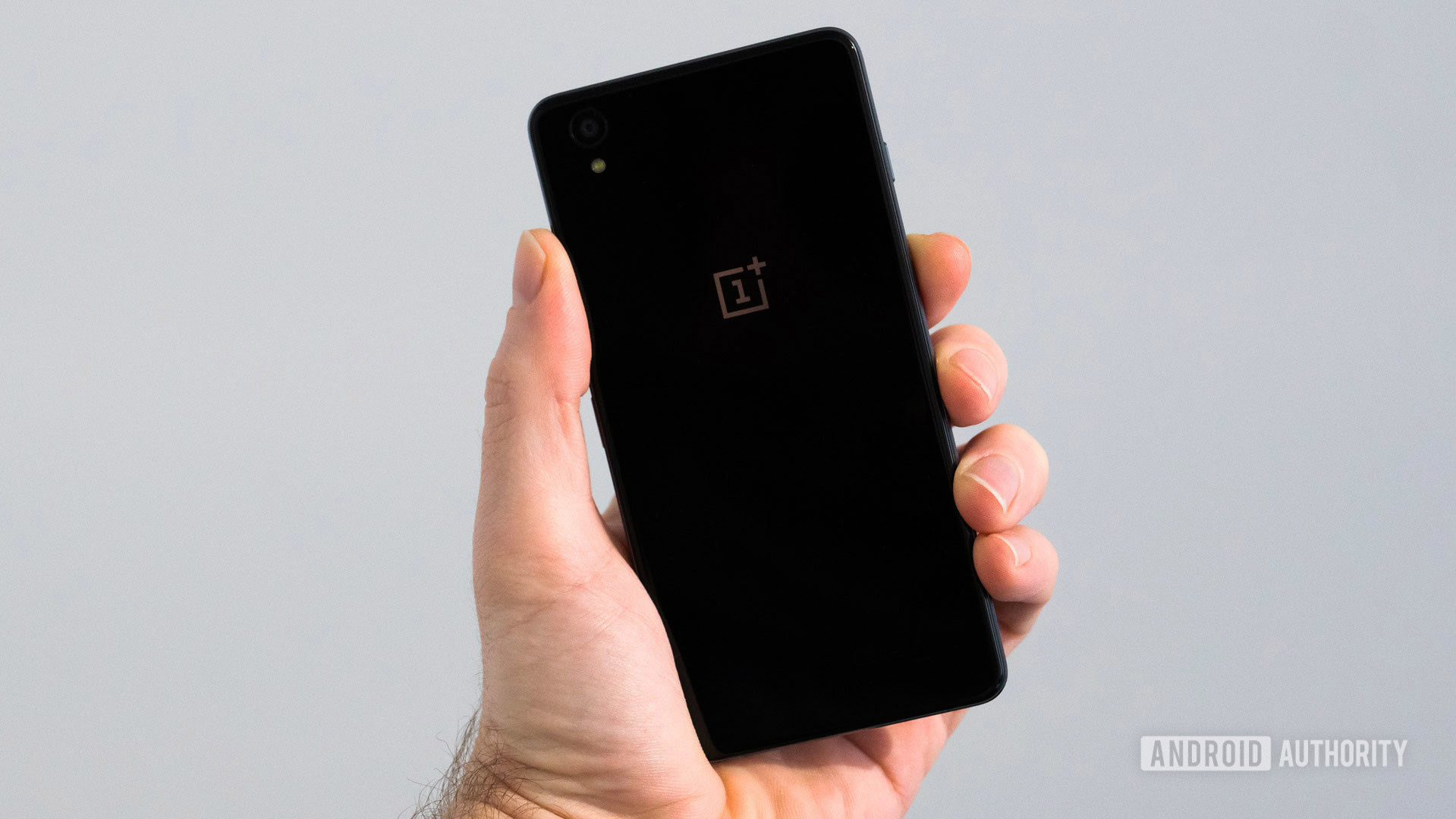
In the Fall of 2015, rumors were ramping up that OnePlus was going to imminently release a third smartphone (with the OnePlus 2 being the first that year and second overall). OnePlus co-founder Carl Pei downplayed the rumor by saying there would only be one flagship phone from OnePlus in 2015.
Enter the OnePlus X, which — true to Carl Pei’s word — is decidedly not a flagship phone. Released at the end of October 2015, the X was the first product from the company not geared as a premium device.
The OnePlus X had the Qualcomm Snapdragon 801, the same chipset in 2014’s OnePlus One. It had 3GB of RAM, 16GB of storage, and cut various corners in the hardware design to keep the price down. Essentially, the device was a reformatting of the One that the company could sell for even less cash — the OnePlus X started at $250, $50 less than the entry-level variant of the One.
Considering that the OnePlus 2 had only just been released — and only cost $70 more — and the OnePlus One was still available in many areas of the world, the OnePlus X had difficulty finding a large audience. Although OnePlus never divulged any sales numbers for the X, we can infer that the phone didn’t do that well because the “X” line never continued.
Still, history looks back very kindly on the OnePlus X. With the runaway successes of budget phones, the OnePlus X was kind of ahead of its time. Eventually, with the launch of the OnePlus Nord and its related line, the idea behind the OnePlus X can now live on in at least some capacity.
OnePlus X fast facts:
- The OnePlus X launched with Android 5.1.1 Lollipop, and its final official update was Android 6.0.1 Marshmallow.
- As with every one of the OnePlus phones thus far, you could only buy the OnePlus X with an invite code. However, within a few months after its launch, the company allowed full open sales of the device. This is another piece of evidence suggesting the phone didn’t sell as well as the company had hoped.
- There were 10,000 ceramic versions of the OnePlus X created. It had the same internals as the regular version, but its premium build materials raised its price to $399. This didn’t make much sense, as the more powerful OnePlus 2 started at $70 less.
- The OnePlus X featured the famous hardware alert slider, something the OnePlus One didn’t have. It also featured a microSD card slot, something OnePlus rarely offers and has never offered in its flagships.
- In 2015, the price of the phone started at $250.
OnePlus 3: The return of the flagship killer
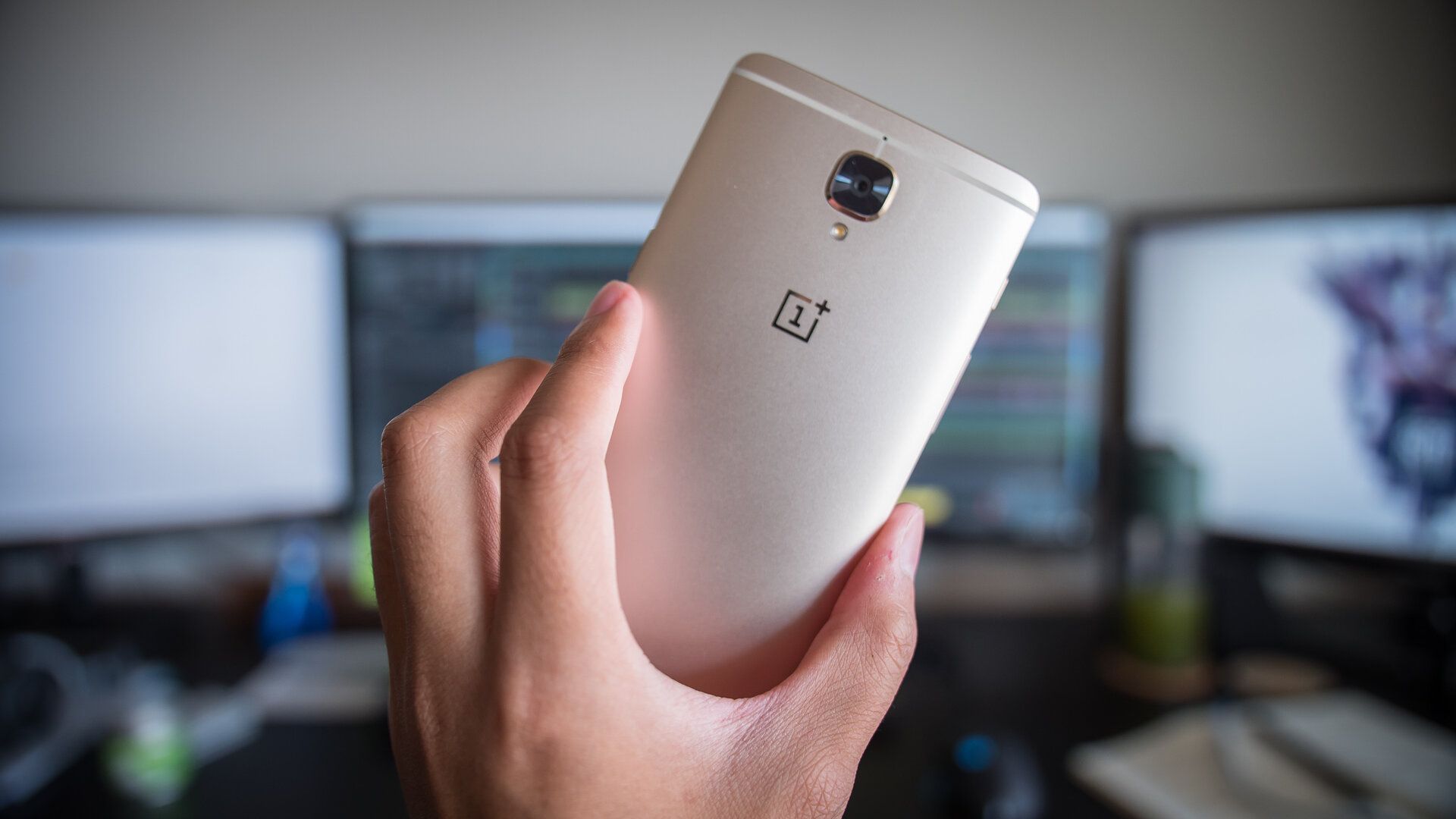
Although OnePlus had one bonafide hit smartphone under its belt with the OnePlus One, the OnePlus 2 and OnePlus X failed to replicate the same love. While the OnePlus 2 likely sold better than the One, it didn’t see the same positivity from the media and OnePlus’ ravenous fanbase. Meanwhile, the OnePlus X was more of a one-off experiment than anything else.
Enter the OnePlus 3, the company’s first total rethinking of how a OnePlus smartphone looks, feels, and functions. Taking some design cues from the incredibly popular HTC One M7 and One M8 from a few years prior, the OnePlus 3 had a classy-looking metal chassis, some sexy rounded corners, huge bumps in internal specs, and, possibly best of all, no invite system nonsense to hinder buyers from getting it.
The OnePlus 3 redefined what a OnePlus smartphone could be.
If the OnePlus 2 was a stumbling block and the OnePlus X was a fun little side project, the OnePlus 3 was the proper follow-up to the OnePlus One: the return of the flagship killer.
OnePlus also used the OnePlus 3 to correct some of its earlier mistakes. It brought back NFC support and fixed compatibility issues that the OnePlus 2 saw with its USB-C port. It also enhanced the fingerprint scanner, a sore spot for users with the OnePlus 2.
One of the only huge criticisms of the device is that, for some reason, OnePlus decided to make the battery smaller than the one in the OnePlus 2. This was a curious move, but it wouldn’t take long for the company to fix that error (see the next section).
Sales numbers are, as usual, hard to come by with the OnePlus 3. Even if we had them, though, they wouldn’t tell the whole story since the device was discontinued only five months after its launch due to the release of the next phone on this list.
OnePlus 3 fast facts:
- The OnePlus 3 launched with Android 6.0.1 Marshmallow, and its final official update was Android 9 Pie. That means the device got a whopping four versions of Android, something basically unheard of in the industry at the time.
- OnePlus’ proprietary fast-charging system — then known as Dash Charge — debuted with the OnePlus 3. Dash Charge was a rebranded and slightly customized version of OPPO’s VOOC charging system, once again suggesting OPPO had a massive hand in OnePlus’ early development.
- When the OnePlus 3 received its update to Android 7.0 Nougat, the update allowed the phone to cheat benchmark scores by overclocking the processor temporarily to game the system. OnePlus apologized for the issue and removed it after widespread backlash erupted against manufacturers cheating benchmark scores.
- Although still with a larger display, the OnePlus 3 was slightly smaller than the OnePlus 2. In the days when smartphones seem to get bigger and bigger, it’s interesting to think about phones getting smaller with a new generation!
- In 2016, the price of the phone started at $400.
OnePlus 3T: The step up to perfection
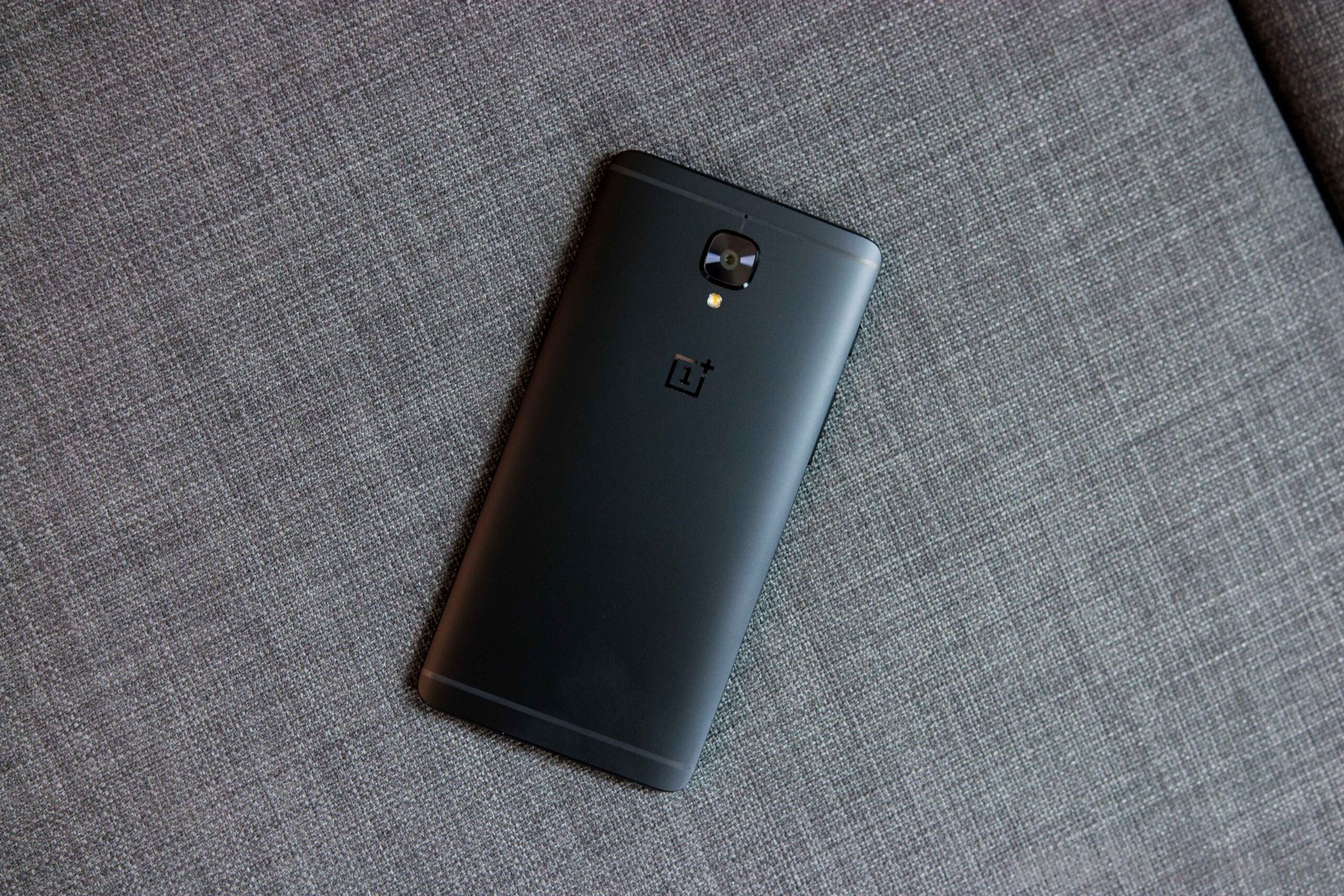
The OnePlus 3 launched in the middle of June 2016. In November, only five months later, the company announced a refresh of that device known as the OnePlus 3T. This was the first time the company had ever released two flagship smartphones in one year.
The OnePlus 3T looked almost exactly like the OnePlus 3 but featured a few upgrades that made it overall a better device. The processor got a slight upgrade to the Snapdragon 821, and the battery got a pretty significant upgrade to 3,400mAh — 400mAh more than the one in the OnePlus 3.
The 3T also added a more premium variant with 128GB of internal storage and an upgraded selfie camera. Overall, though, the OnePlus 3T was just a simple tweaking of the OnePlus 3.
The 3T was a terrific phone. Even so, diehard OnePlus fans were miffed by its existence. Many had literally just bought the OnePlus 3. The company then added insult to injury by discontinuing production of the OnePlus 3 entirely, making it probably the most short-lived phone in OnePlus’ history.
If you ignore that, though, the OnePlus 3T was probably one of the best smartphones of 2016. It fixed the very few problems with the OnePlus 3 and still could be bought for a relative bargain at just $440. For comparison, the similarly spec’d Samsung Galaxy S7 started at $670 that year.
Although we don’t know much about how many OnePlus 3T units the company sold, fans frequently cite the device as being the best device ever from the brand. There are probably people reading this article on a 3T, as quite a few people refuse to stop using it as their daily driver!
OnePlus 3T fast facts:
- The OnePlus 3T launched with Android 6.0.1 Marshmallow. Its final official update was Android 9 Pie.
- By the time OnePlus launched the 3T, it had nailed down its supply chain enough to be able to give immediate delivery of its products. It would sometimes only take days to get to your doorstep.
- The OnePlus 3T had a new color option called Gunmetal, a slightly darker change from the OnePlus 3’s Graphite color.
- OnePlus elected to skip updating the OnePlus 3 and 3T to Android 8.1 Oreo, letting both devices sit on Android 8.0 until the final update to Android 9 Pie arrived.
- In 2016, the price of the phone started at $440.
OnePlus 5: The first (and last) of its kind
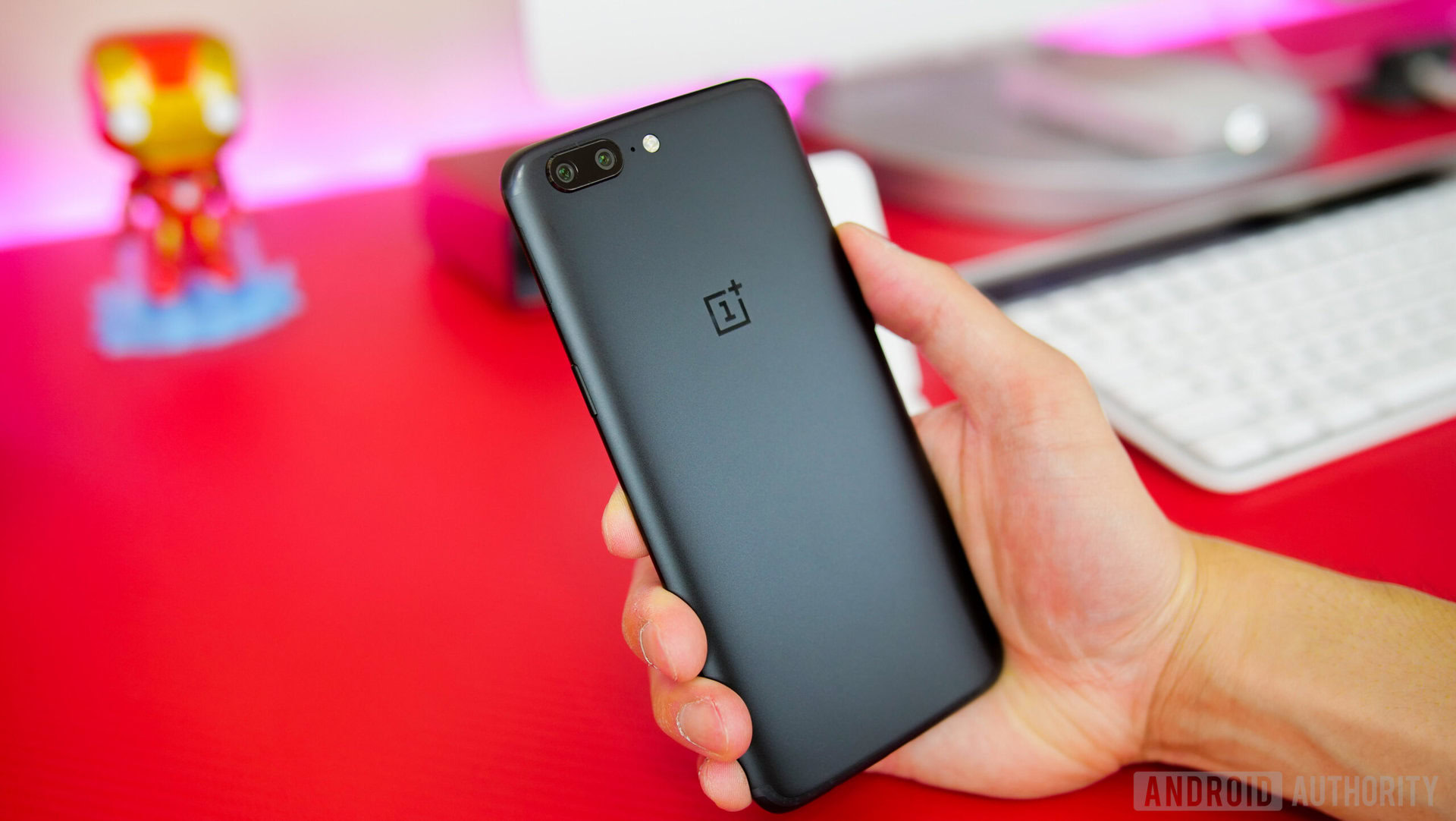
After the launch of the OnePlus 3 and the unexpected launch of the OnePlus 3T, people naturally assumed that we’d see a OnePlus 4 in 2017. However, OnePlus surprised us again by skipping the number four and going straight to five with the OnePlus 5.
Although the company never gave a formal reason for skipping the OnePlus 4, it likely had to do with tetraphobia, a highly prevalent superstition in East Asian culture. Tetraphobia, quite literally, is the fear of the number four. In Mandarin Chinese, the pronunciation of the word “four” is very similar to the pronunciation of the word “death.”
Regardless, the OnePlus 5 landed in June 2017 with great reviews and stellar sales. Although the design took a lot of cues from the OnePlus 3 and 3T from the previous year, it had a more minimalistic look with more emphasis on tiny details.
However, the most notable change for the OnePlus 5 was the introduction of two rear camera lenses. Over the entire history of OnePlus phones, the camera system has been a constant sore spot, with most critics saying they are sub-par when compared to other similar devices in the market. With the OnePlus 5, the company made its first big attempt to shut down that criticism, even going so far as to work with DxO — the French photography company behind venerable reviews site DxOmark — to develop the OnePlus 5’s cameras.
With two lenses on the rear, OnePlus came out ahead of many other companies that had yet to introduce flagship phones with multiple rear lenses, including Samsung and Google. Even Apple had only just introduced a multi-lens system the year prior on the iPhone 7 Plus (the vanilla iPhone 7 still had a single rear lens). With a starting price of just $480, the OnePlus 5 undercut the iPhone 7 Plus’ entry-tier price of $770 by a considerable margin.
OnePlus said that the OnePlus 5 was the fastest-selling phone in its history, at that point.
OnePlus 5 fast facts:
- The OnePlus 5 launched with Android 7.1.1 Nougat, and its final official update was Android 10.
- Interestingly, OnePlus again decided to lower the battery capacity of the OnePlus 5 as compared to the OnePlus 3T. The difference is slight (only 100mAh), but still curious.
- One of the most significant controversies with the OnePlus 5 was the so-called “jelly scrolling effect.” If you swiped quickly through a long web page, the text and images would appear to swell as if made of jelly. The problem was the display itself, which was inverted for design reasons.
- The OnePlus 5 was the first phone from the company — and one of only a very few phones in the industry at the time — to offer a variant with 8GB of RAM.
- In 2017, the price of the phone started at $480 for the version with 6GB of RAM and 64GB of internal storage.
OnePlus 5T: The overhaul
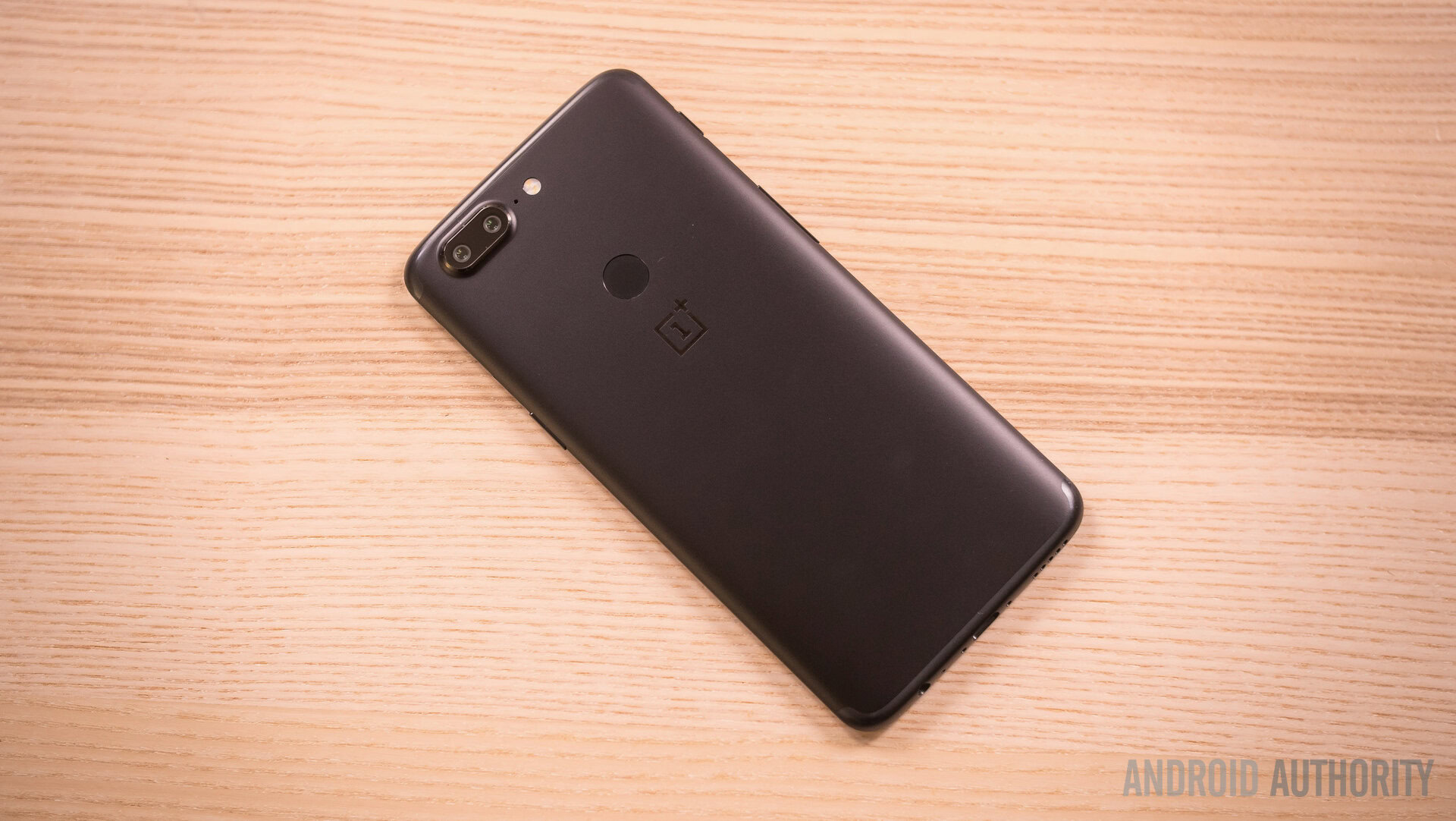
From the OnePlus One in 2014 to the OnePlus 5 in 2017, all the OnePlus phones shared a similar design. Sure, the Sandstone back disappeared with the OnePlus 3, and the OnePlus 5 gave us a dual rear camera system. Still, the overall idea of a minimalist design with a physical home button/fingerprint sensor on the front stayed the same.
Not so with the OnePlus 5T. For the first time, the front of the device became all screen, and the fingerprint sensor moved to the back. It wasn’t the first device to do this by far, but it was a pretty significant jump to make with a “T” model phone. After all, the OnePlus 3T looked the same as the OnePlus 3, but now it was easy to tell the difference between the 5 and 5T just with a quick glance.
Of course, we were still years away from a nearly bezel-less experience when the OnePlus 5T landed, so it still had a significantly sized forehead and chin. But now, there was so much more room for a screen on a device that was, physically, about the same size as the OnePlus 5.
Despite the drastic change in design, the OnePlus 5T didn’t differ all that much from the OnePlus 5. It had the same processor (the Snapdragon 835), the same RAM/internal storage options, the same battery, etc. It even had the same price.
OnePlus had some fun releasing special editions of the 5T. There was the Star Wars edition to tie in with the release of Star Wars: Episode VIII — The Last Jedi, as well as a Lava Red colorway.
OnePlus 5T fast facts:
- The OnePlus 5 launched with Android 7.1.1 Nougat, and its final official update was Android 10.
- The OnePlus 5T came with a Face Unlock feature, a first for a OnePlus device. However, since it was based on 2D scanning from the single camera sensor on the front, you couldn’t use it to authenticate purchases as it wasn’t as secure as a fingerprint scan. The OnePlus 5 later got this same feature.
- Android Authority readers concluded that the OnePlus 5T was the phone with the best value for the money in 2017, beating out the Nokia 8 and the Motorola Moto Z2 Force. It also was an honorable mention for our Best Phone of the Year award.
- OnePlus introduced the Parallel Apps feature with the OnePlus 5T. Parallel Apps allows you to have two instances of one app running simultaneously. This is helpful if, say, you have two Snapchat accounts and don’t want to log in and out of them on your phone constantly.
- In 2017, the price of the phone started at $480 for the version with 6GB of RAM and 64GB of internal storage.
OnePlus 6: The opening act
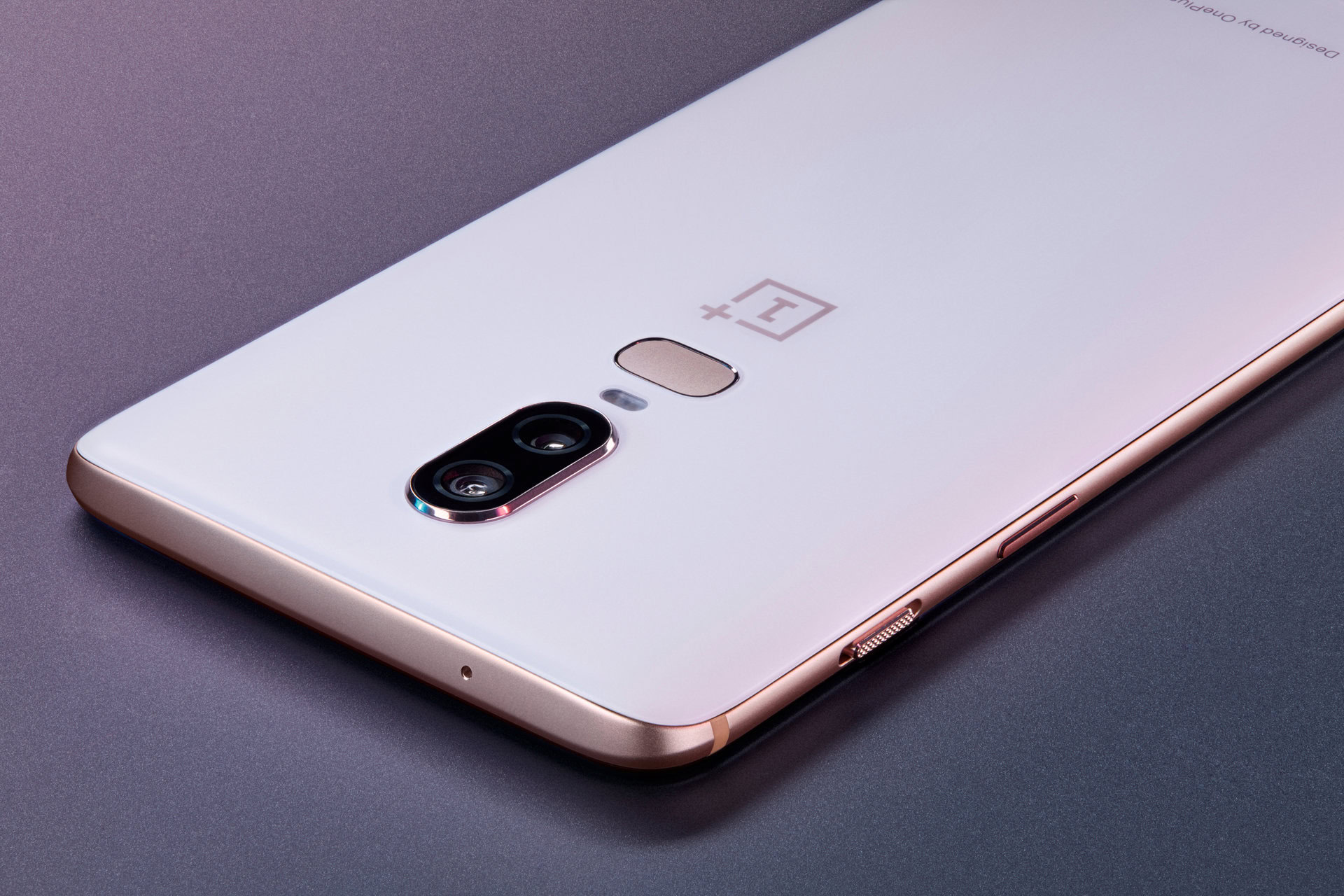
At the end of 2017, Apple unveiled the iPhone X. The phone was the first from Apple to feature a notched display. This allowed for nearly bezel-less sides and a very, very small chin. This design idea originated earlier in the year with the Essential Phone, and other Android OEMs had quickly jumped on the bandwagon.
The notch was (and still is) a highly controversial design element. With rumors ramping up for the OnePlus 6 in early 2018, fans were concerned about notches. Sure enough, their concerns became a reality when co-founder Carl Pei told The Verge, “learn to love the notch,” and gave an exclusive first look at what the notch on the OnePlus 6 looked like.
Some saw the OnePlus 6 as the spiritual successor to the Google Nexus series.
This initial wave of lousy publicity put a considerable damper on the PR machine running to promote the OnePlus 6. After the success OnePlus had had, the OnePlus 6 was poised to be a breakthrough for the brand. It would move it out of the world of niche smartphones and into the mainstream. This bad press wasn’t helping.
Luckily for OnePlus, the initial notch backlash didn’t hurt it too much, as the OnePlus 6 was well-received by fans and critics. In our review we called it “the spiritual successor to the Nexus,” which are not words we would use lightly.
In fact, the device sold so well that OnePlus broke its usual silence on company revenue to announce that it sold over a million units of the OnePlus 6 in just one month. That’s an astounding achievement for just over four years of the company’s existence.
However, the OnePlus 6 ended up being the opening act for the phone that would genuinely break OnePlus into the mainstream.
OnePlus 6 fast facts:
- The OnePlus 6 launched with Android 8.1 Oreo; its final upgrade was to Android 11.
- With the OnePlus 6, the company built a phone out of mostly glass for the first time. Initially, the thought was that this would enable wireless charging, a feature previous metal builds would have prohibited. However, wireless charging didn’t debut on a OnePlus phone until 2020 with the OnePlus 8 Pro.
- As with the OnePlus 5T, the company released a special edition of the OnePlus 6 to tie in with a blockbuster film, this time to coincide with Avengers: Infinity War. The special edition phone came with plenty of Marvel-themed accessories and a unique colorway.
- The OnePlus 6 was also the first phone from the company to be a part of the Android beta program. This enabled users to install beta versions of Android P at the same time as Pixel phones.
- In 2018, the price of the phone started at $530. This was for the version with 6GB of RAM and 64GB of internal storage.
OnePlus 6T: The one for everyone
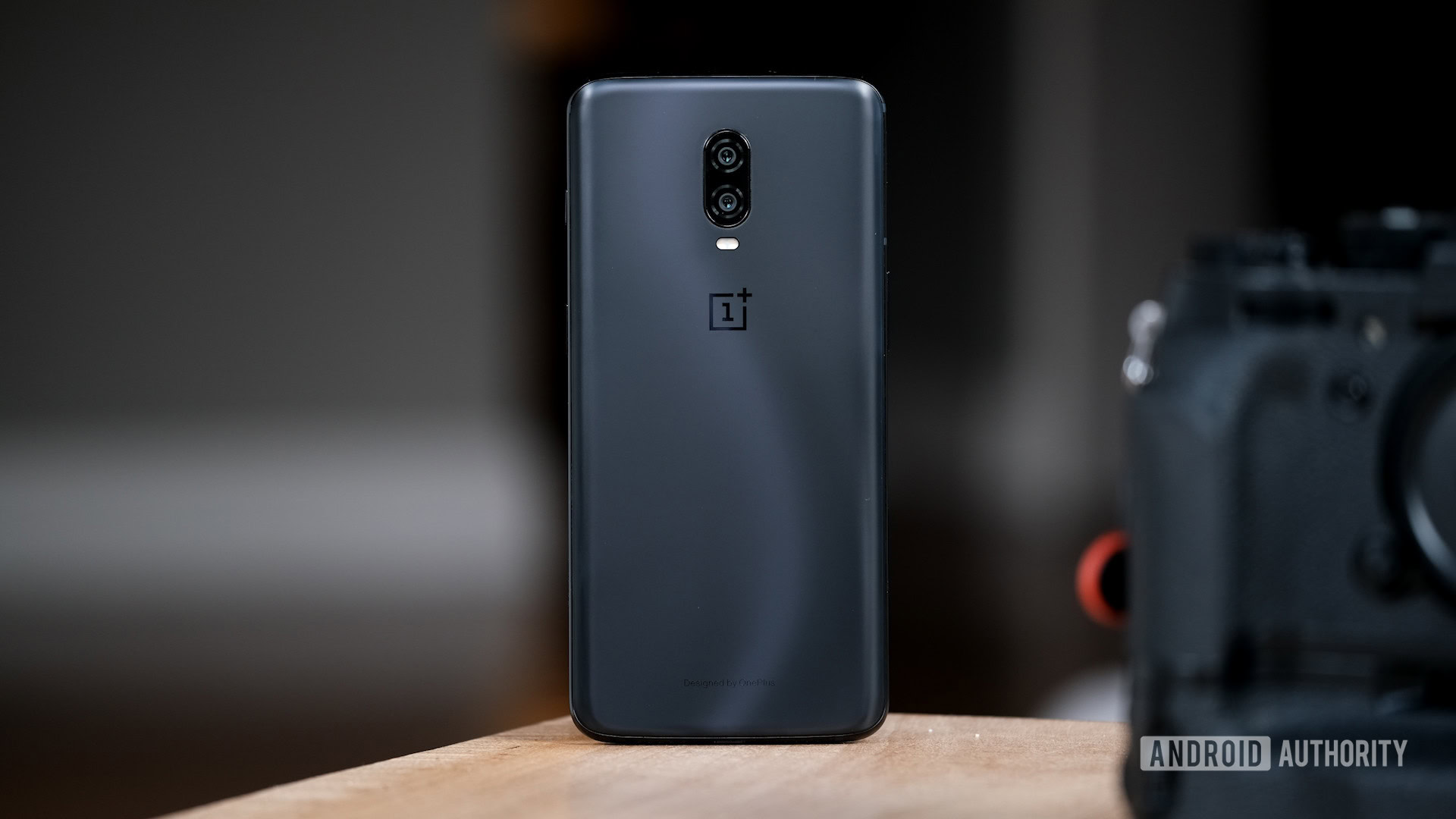
With the OnePlus 6 being the company’s fastest- and best-selling phone to date, how could it keep growing? Here in the United States, the best way for it to grow would be to finally get a carrier partnership. This would allow US buyers to simply walk into their local shops and buy one.
OnePlus had already made carrier partnerships in other parts of the world. Getting one in the US would truly be a win. As you probably know by now, the company did this by partnering with T-Mobile.
With T-Mobile’s help, OnePlus saw even its record-setting sales of the OnePlus 6 obliterated. CEO Pete Lau said that it sold a stunning 249% more units of the 6T in the US than it did the OnePlus 6.
Undoubtedly, the OnePlus 6T marks the turning point for the brand. It’s when the company finally stepped out of its original incarnation as an online-only niche OEM to a global company that could actually threaten the likes of Samsung, HUAWEI, and more.
Even if you ignore all that, the OnePlus 6T was such a fantastic device. The move to a barely-there waterdrop notch was a welcome one, and the enhancements to the display, cameras, and internal specs were all excellent moves — not to mention the debut of the in-display fingerprint sensor. The only thing that wasn’t great about the 6T is that it marks the end of the headphone jack — every flagship OnePlus phone since this one hasn’t had the much-loved legacy port.
OnePlus 6T fast facts:
- The OnePlus 6T launched with Android 9 Pie, and its final upgrade was to Android 11.
- For all of 2018 and into early 2019, the OnePlus 6T was the only smartphone you could buy at a US carrier store with an in-display fingerprint sensor.
- Although OnePlus slightly increased the price of the OnePlus 6T as compared to the OnePlus 6, the base model came with twice as much internal storage, making the $20 increase well worth it. Higher-end models of the OnePlus 6T saw no price increases, either.
- The OnePlus 6T McLaren Edition was the first time the company partnered with the famous British car brand. The device featured a slight bump in RAM and a faster charging system. Not to mention a cool black-and-orange colorway to match the McLaren branding.
- In 2018, the price of the phone started at $550 for the version with 6GB of RAM and 128GB of internal storage.
OnePlus 7: The divide
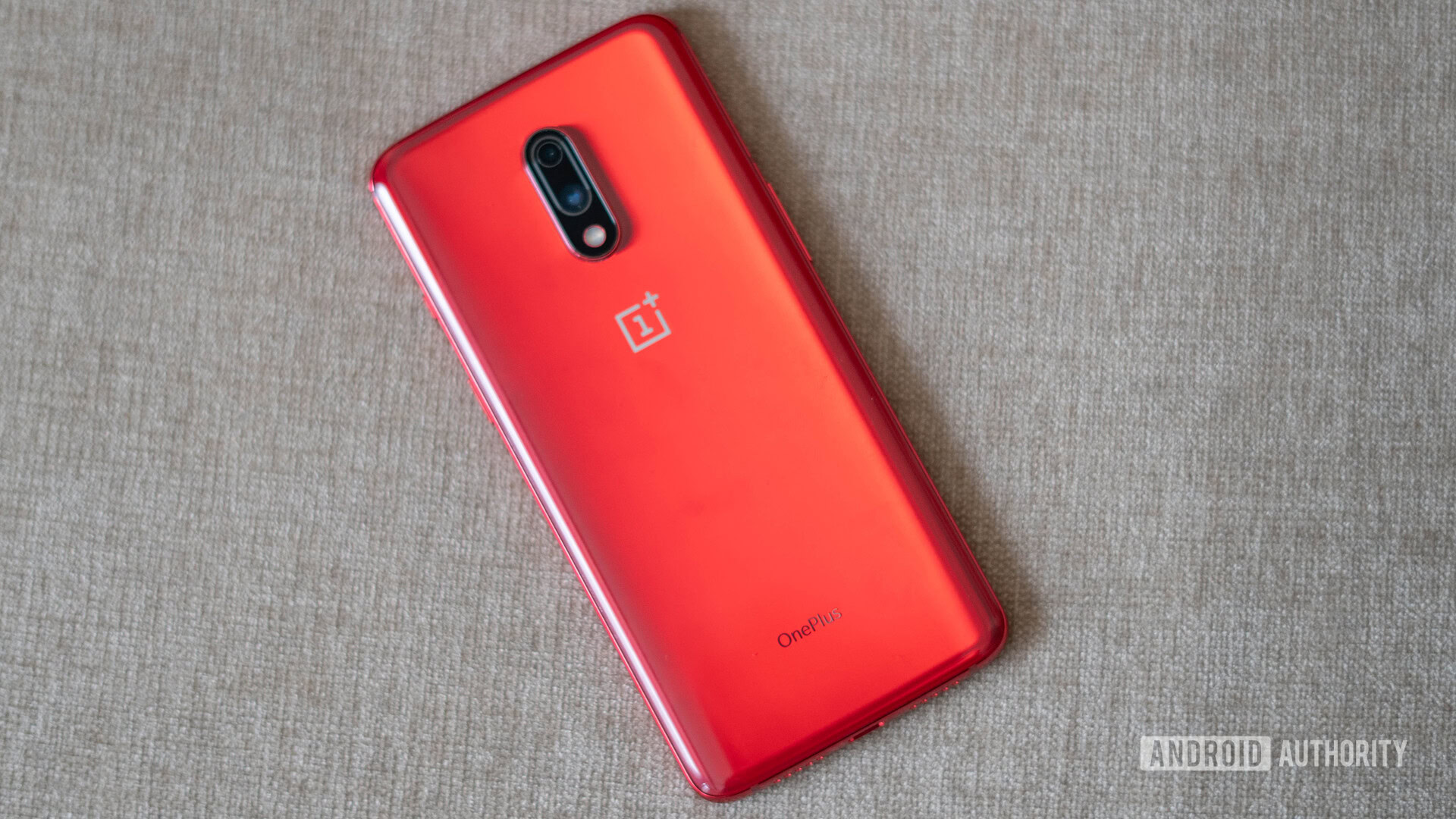
The OnePlus 6 and 6T were incredibly successful. All eyes in the industry were on OnePlus for the inevitable launch of the OnePlus 7 series. It was no secret that the company was steadily increasing the entry-level price of its devices. Would the company keep that trend going and release a phone twice as expensive as the OnePlus One just five years after its debut?
It turns out the answer to that question is both yes and no. That’s because OnePlus, for the first time, released two different versions of its flagship: the OnePlus 7 and the OnePlus 7 Pro. The OnePlus 7’s price stayed under $600, preventing it from doubling the cost of the OnePlus One. The Pro variant, though, flew past the $600 mark, allowing the company to have its cake and eat it, too.
However, things got complicated when the company decided to launch the devices only in some regions of the world. Here in the United States, we couldn’t get the OnePlus 7, with only the 7 Pro being available from T-Mobile and even the official OnePlus online store.
Ultimately, it didn’t really matter, because the OnePlus 7 was more like a rehash of the OnePlus 6T. It looked like the OnePlus 6T and only offered some nominal internal upgrades. It was undoubtedly a great phone, but with T-Mobile still selling the OnePlus 6T, there was no reason to have a clone on the next shelf.
In that sense, the OnePlus 7 Pro is the proper follow-up to the OnePlus 6T.
OnePlus 7 fast facts:
- The OnePlus 7 launched with Android 9 Pie, and its most recent official update was Android 11. OnePlus says it will get Android 12 in 2022.
- The two major upgrades the OnePlus 7 saw as compared to the OnePlus 6T were in the processor and cameras. The processor got an upgrade to the Snapdragon 855. The cameras got bumped from 2018 sensors to 2019 sensors, including a 48MP main. However, nearly every other spec is the same across both phones.
- Shortly after the launch of the OnePlus 7, the company announced a red colorway of the phone. This colorway — simply called Red — was exclusive to the OnePlus 7. No other phones in the 7 series got it.
- Mere months after the launch of the OnePlus 7, it saw a significant price reduction. The OnePlus 7T saw a similar reduction, suggesting it is better to wait a few months after launch to buy a non-Pro OnePlus phone.
- In 2019, the price of the phone started at €550. This was for the version with 6GB of RAM and 128GB of internal storage.
OnePlus 7 Pro: The overshoot
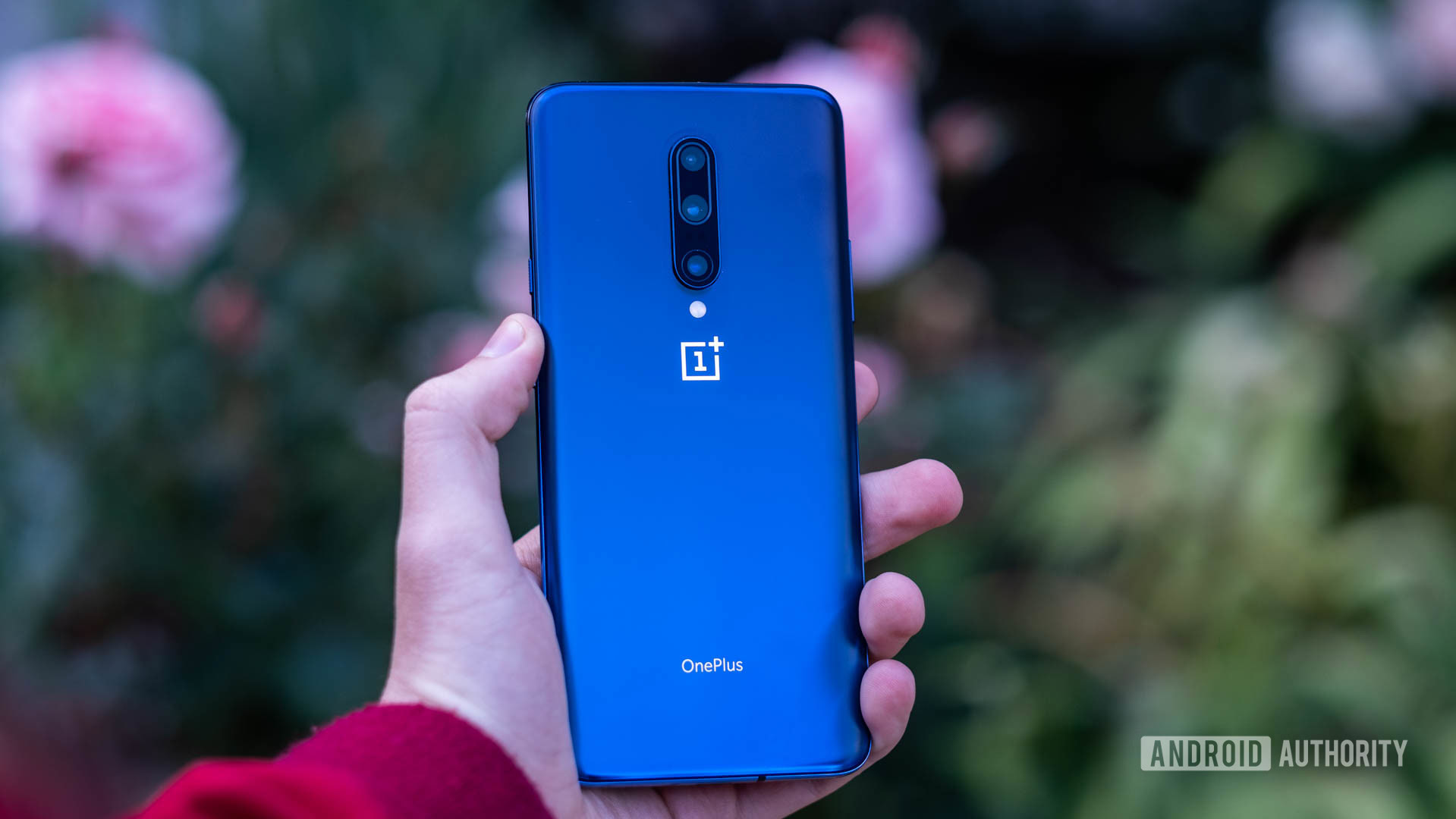
The OnePlus 7 Pro had to be much better than the OnePlus 7 and OnePlus 6T to justify the price increase. While the company achieved that, it might have done too good of a job, as the OnePlus 7 Pro was so much better than the OnePlus 6T that it kind of painted itself into a corner.
The OnePlus 7 Pro introduced a few firsts to OnePlus phones and the entire smartphone market in general. It was the first commercially released phone to have UFS 3.0 storage speeds and the first with a 90Hz refresh rate on an OLED display. It also was the first phone with a pop-up selfie camera to hit store shelves in the United States.
The OnePlus 7 Pro was the first phone from the company with a triple-lens rear camera, which helped it earn a high DxOmark score, keeping it in the top ten for months. Oh yeah, and it also had 30W wired charging and up to a ridiculous 12GB of RAM.
The absolute most you’d pay for a OnePlus 7 Pro on launch day was $750. Frankly, OnePlus may have overshot things with the OnePlus 7 Pro. After all, where does it go from here? The OnePlus 7T Pro will tell you the answer to that question.
OnePlus 7 Pro fast facts:
- The OnePlus 7 Pro launched with Android 9 Pie, and its most recent official update was Android 11. OnePlus says it will get Android 12 in 2022.
- The pop-up selfie camera, according to OnePlus, is capable of 300,000 pop-ups. The phone will even warn you if you’re using too many pop-ups and automatically retract if it senses the phone has been dropped.
- The OnePlus 7 Pro does not have an official IP rating. Still, the company was confident enough about the device’s water resistance that it dropped it into a bucket of water and let it be completely submerged.
- For the first time on a OnePlus phone, the OnePlus 7 Pro comes with a 1440p display. Up until this point, every phone from the company maxed out at 1080p. The 90Hz refresh rate works with either 1080p or 1440p resolutions.
- In 2019, the price of the phone started at $670 for the version with 6GB of RAM and 128GB of internal storage.
OnePlus 7T: The Goldilocks
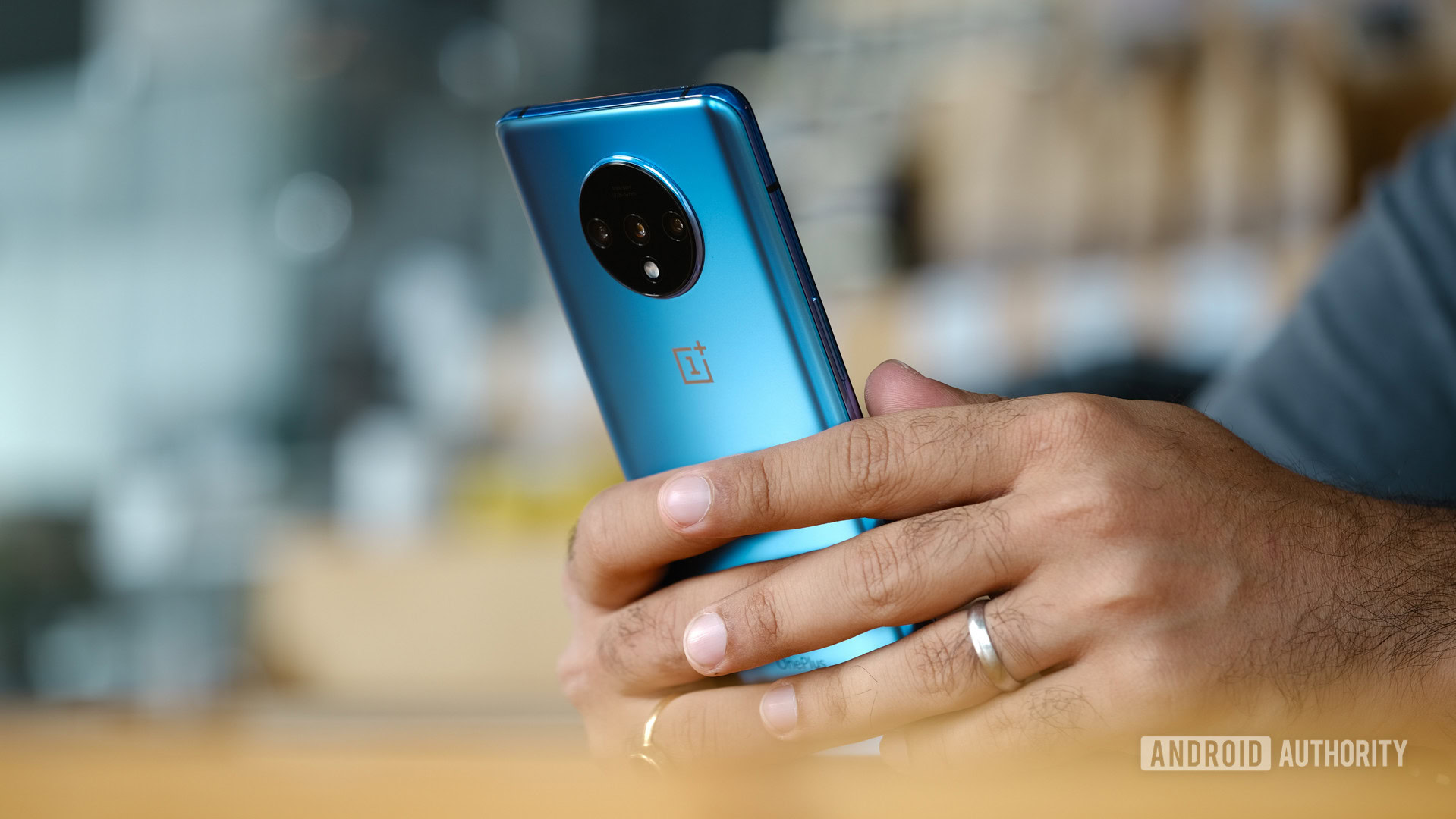
Interestingly, the “T” series from OnePlus is all out of whack now. Initially, the OnePlus 3T was a minor upgrade over the OnePlus 3. Then, with the OnePlus 5T and the OnePlus 6T, the company instead introduced wholly new design elements, making the phones drastically different from their predecessors.
Then, with the OnePlus 7, the company made a phone that was essentially a clone of the OnePlus 6T but with some nominal upgrades. In just a few generations, we went from the “T” series being the slight upgrade to the main series being the slight upgrade over the previous generation. It’s like we’re in reverse!
The OnePlus 7T fits in well with this “backward” system since it features a whole new design as well as upgraded internals as compared to the OnePlus 7. For example, it brought over the triple-lens rear camera system of the OnePlus 7 Pro but in a brand-new (and soon abandoned) circular module. It keeps the waterdrop notch of the OnePlus 7, but makes the screen slightly thinner and slightly taller, kind of like the OnePlus 7 Pro’s all-screen display. Aside from the new camera module, the OnePlus 7T looks like someone mashed together a OnePlus 7 and a OnePlus 7 Pro, making it the best of both worlds.
Of course, there were the usual internal upgrades, such as the Snapdragon 855 Plus processor, 8GB of RAM for the entry-level option, a larger battery, etc. Overall, though, the OnePlus 7T feels more like what the OnePlus 7 should have been.
Thankfully, OnePlus kept the price for the OnePlus 7T very reasonable at just $600. Eventually, OnePlus lowered the price by an astounding $100, making the OnePlus 7T the best-value smartphone of 2020 (even though it launched in 2019!).
OnePlus 7T fast facts:
- The OnePlus 7T launched with Android 10 out of the box. It is now on Android 11 and will likely receive updates through Android 13 (although we can’t guarantee that).
- T-Mobile sold the OnePlus 6T first and then carried it and the OnePlus 7 Pro together. However, it eventually replaced the 6T and 7 Pro with the 7T.
- Although the blue colorway of the OnePlus 7T looks a lot like the one on the OnePlus 7 Pro, they are actually different. The OnePlus 7 Pro’s Nebula Blue is a few shades darker than the 7T’s Haze Blue.
- The OnePlus 7T also has a 90Hz refresh rate, a feature that debuted with the OnePlus 7 Pro. However, the 7T’s display is locked at 1080p to keep costs down.
- In 2019, the price of the phone started at $600 for the version with 8GB of RAM and 128GB of internal storage.
OnePlus 7T Pro: The rehash
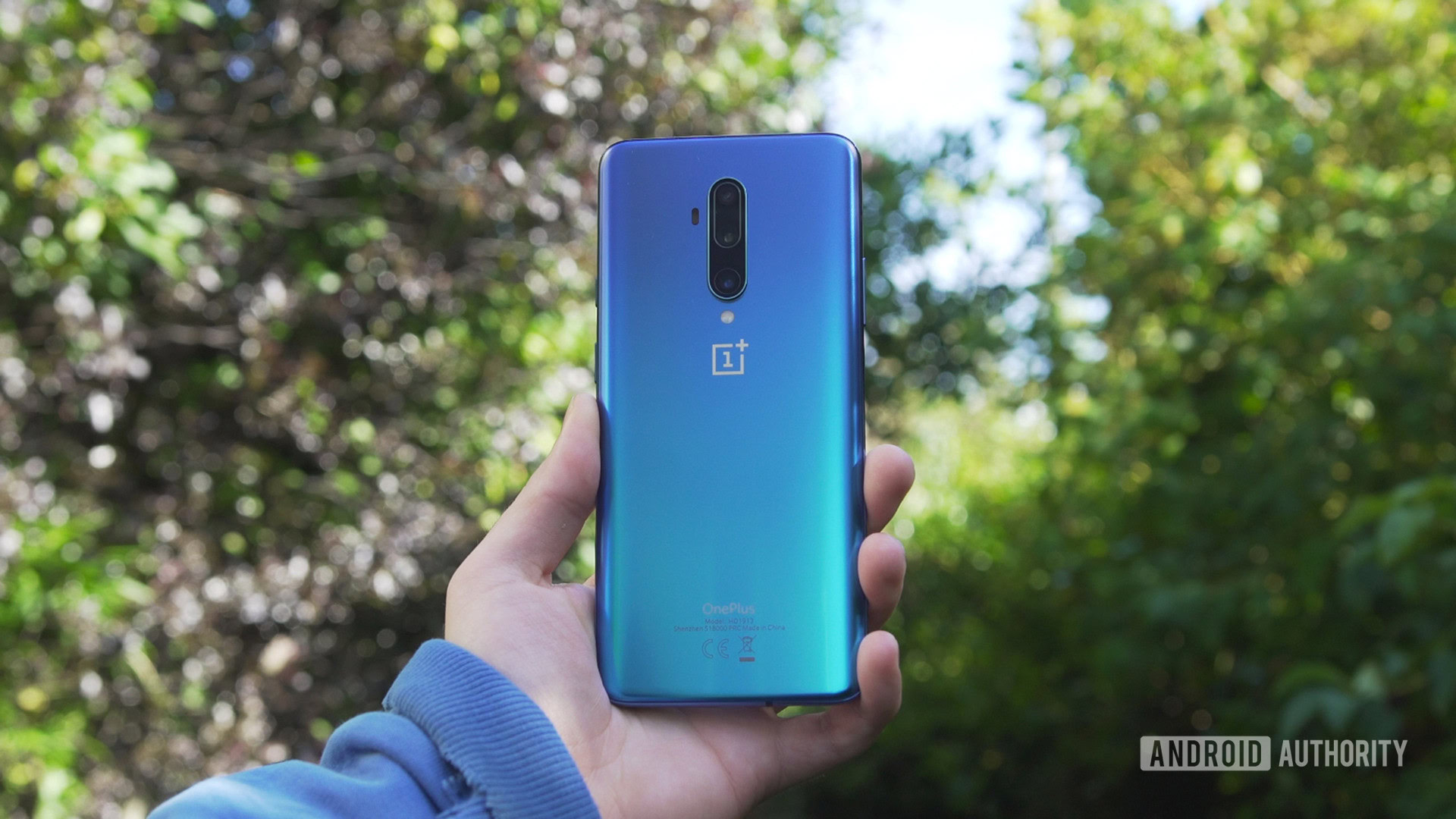
Remember how we nicknamed the OnePlus 7 Pro “the overshoot”? Well, the OnePlus 7T Pro helps prove that point, considering it is a “T” model upgrade that offers only a handful of upgrades over the original 7 Pro.
In essence, the 7T Pro is just a 7 Pro with a slightly bigger battery (we’re talking 85mAh bigger) and a slightly upgraded processor (the SD855 Plus as compared to the regular SD855). Aside from these minor details, the phones are identical.
OnePlus must have realized that the 7T Pro was a bizarre entry in its line. It only made the device available in certain countries. Here in the US, if you wanted an upgrade over the OnePlus 7T, you needed to go to the OnePlus 7 Pro. Aside from the processor, is still the superior device in almost every respect.
The 7T Pro eventually made its way to the United States in the form of the OnePlus 7T Pro 5G McLaren Edition. You could get it from T-Mobile. As its name suggests, it’s a 5G version of the OnePlus 7T Pro with the McLaren color scheme makeover.
OnePlus 7T Pro fast facts:
- The OnePlus 7T Pro launched with Android 10 out of the box. It is now on Android 11 and will likely receive updates through Android 13 (although we can’t guarantee that).
- Although the camera systems are nearly identical across the 7T Pro and 7 Pro, the 7T Pro gets the ability to record ultra slow-motion 720p video at 960 fps. This feature has not been ported to the OnePlus 7 Pro (but has been ported to the OnePlus 7T).
- The OnePlus 7T Pro won smartphone of the year awards from several organizations, including the GSM Association.
- The OnePlus 7 Pro came in a color known as Almond in addition to Nebula Blue. However, the OnePlus 7T Pro only had Haze Blue as an option.
- In 2019, the price of the phone started at £700 for the version with 8GB of RAM and 256GB of internal storage.
OnePlus 8: The upgrade with some downgrades
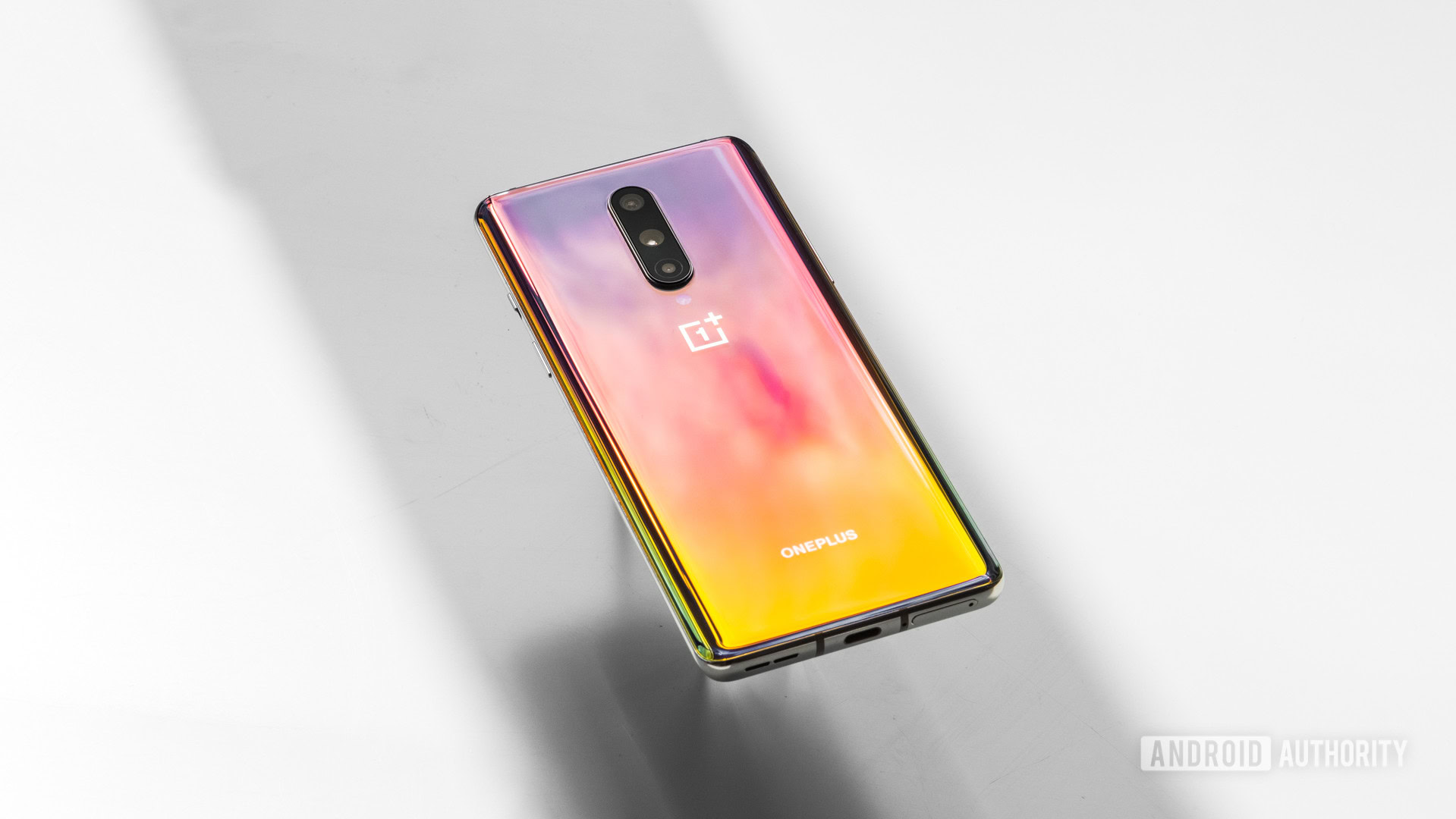
The OnePlus 7 Pro and OnePlus 7T were some of the company’s best-received products. The only problem was that the difference between Pro and non-Pro phones wasn’t quite clear. Sure, pricing and specs tables give hints as to which phone is “better.” OnePlus definitely needed to do a better job at making the differences easy for consumers to understand.
Enter the OnePlus 8 series. The vanilla OnePlus 8 looks very different from the OnePlus 7T and OnePlus 7 Pro. It has the expected upgrades in specs, including the 5G Snapdragon 865 processor. However, it also has a few downgrades. Most notably a weaker camera array (who needs a macro lens, seriously?) as well as a display cutout rather than a waterdrop notch.
Outside of the processor upgrade, there’s not too much notable about the OnePlus 8. We even called it “watered down” in the headline of our review. All in all, it’s a perfectly good 2020 smartphone, but nothing to write home about. However, its relatively high price was something to note: starting at $700, OnePlus blew past its previous entry-tier smartphone pricing by $100.
Thankfully, the OnePlus 8 was made readily available throughout most of the world, unlike the OnePlus 7 before it. You could easily get the device here in the US from both Verizon and T-Mobile.
OnePlus 8 fast facts:
- The OnePlus 8 launched with Android 10 out of the box. It already has Android 12, and will likely receive updates through Android 13 (although we can’t guarantee that).
- The OnePlus 8 pictured above is in a colorway called Interstellar Glow. It’s gorgeous. Unfortunately, the OnePlus 8 Pro didn’t come in the same colorway, which is weird.
- With a 4,300mAh battery, the OnePlus 8 had more battery capacity than any previous OnePlus device. Its battery is over 200mAh, bigger than the one in the OnePlus 7T Pro.
- The version of the OnePlus 8 that Verizon carries is slightly different with a slightly different name. The OnePlus 8 5G UW has an IP68 rating, just like the OnePlus 8 Pro. No other OnePlus 8 devices have an IP rating.
- In 2020, the price of the phone started at $700 for the version with 8GB of RAM and 128GB of internal storage.
OnePlus 8 Pro: The fan service

In early 2018, with the launch of the all-glass OnePlus 6, fans of the brand were finally excited to get a OnePlus phone with wireless charging. Unfortunately, that wasn’t to be, as the OnePlus 6 didn’t feature it. Neither did the OnePlus 6T or any phones the company released in 2019.
Finally, that changed in 2020 with the launch of the OnePlus 8 Pro, the first OnePlus phone with wireless charging. Not content to stop there, OnePlus also earned an IP68 rating for every OnePlus 8 Pro device, another thing fans have wanted for years. It was like the answer to so many prayers!
Unfortunately, not all changes for the OnePlus 8 Pro were received warmly. The phone price shot up to an astonishing $900 for the lowest-tier model, precisely three times the price of the OnePlus One from six years prior. The notch-free, all-screen displays of the OnePlus 7 Pro and OnePlus 7T Pro were exchanged for a display cutout housing the solitary front-facing camera, quite rightly hailed as a downgrade rather than an upgrade. Finally, the OnePlus 8 Pro added a chromatic filter camera which we called a “gimmick.” It backfired on the company when people started using it to simulate x-ray vision.
Time will tell how the OnePlus 8 Pro holds up compared to previous devices in the company’s lineup. The COVID-19 pandemic didn’t help sales, though, so it might be difficult to truly say whether the OnePlus 8 series is a sales success or not when the dust settles.
OnePlus 8 Pro fast facts:
- The OnePlus 8 Pro launched with Android 10 out of the box. It already has Android 12, and will likely receive updates through Android 13 (although we can’t guarantee that).
- One of the reasons OnePlus gave for taking so long to deliver wireless charging is that the technology wasn’t as fast as wired charging. With that in mind, the OnePlus 8 Pro wirelessly charges at a super-fast rate of 30W, which is so fast that it needs a special proprietary dock with a cooling system to do it.
- Although OnePlus finally brought an IP rating and wireless charging to the OnePlus 8 Pro, it still hasn’t delivered something else fans want: a microSD card slot. There has never been a flagship OnePlus phone with this feature to date.
- Unlike the OnePlus 7 Pro and OnePlus 7T Pro, there hasn’t been any version of the OnePlus 8 Pro that’s hit a wireless carrier in the US.
- In 2020, the price of the phone started at $900 for the version with 8GB of RAM and 128GB of internal storage.
OnePlus Nord: The back to basics
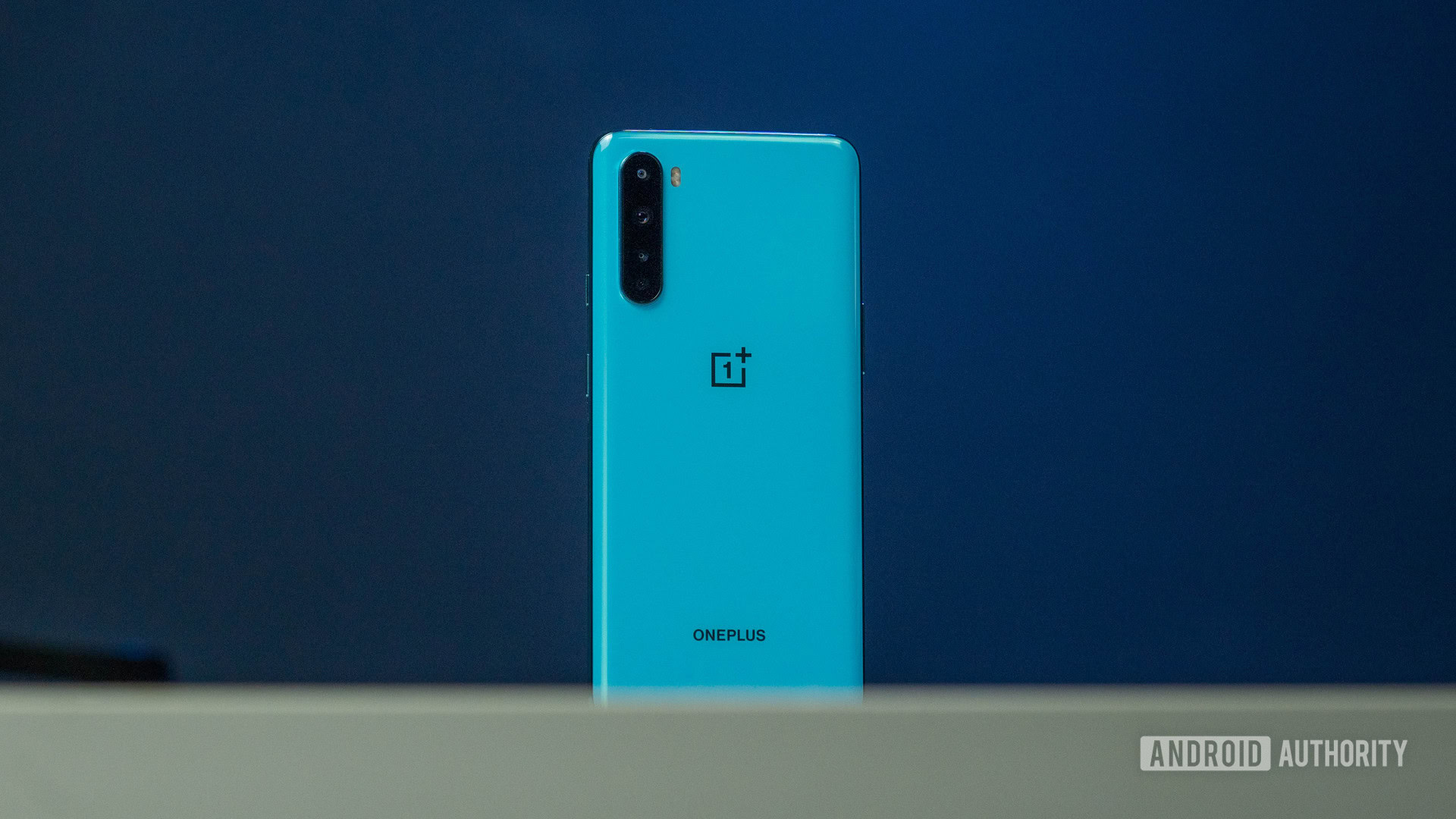
Remember the OnePlus X, which we called “The Experiment?” Well, it could be argued that the experiment is what gave us the OnePlus Nord, only the second phone from the company to not be a flagship-style product. It’s also the second phone from the company to not launch at all in the United States.
Although the Nord looks a lot like other OnePlus flagships (specifically the OnePlus 8 series), it features a weaker processor in the Snapdragon 765G. This enables it to connect to 5G networks and still produces a snappy software experience, but it’s not nearly as powerful as the Snapdragon 865.
The reduction in processing power, though, allowed OnePlus to keep the entry price for the Nord reasonably low. It is roughly 55% cheaper in Europe when compared to the OnePlus 8 Pro.
The OnePlus Nord is not a one-and-done product as we saw with the OnePlus X. The company has promised that “Nord” is the name of an entirely new line of products and is not just limited to smartphones. As such, we would see many more Nord-branded phones, headphones, and other devices in the future.
OnePlus Nord fast facts:
- The OnePlus Nord launched with Android 10 out of the box. It is now on Android 12 and will likely receive updates through Android 13 (although we can’t guarantee that).
- The OnePlus Nord has a dual-lens selfie camera on the front. This is the first time that a OnePlus device has had two lenses for selfies.
- OnePlus was able to bring a bunch of flagship-esque features to the Nord, including a quad-camera on the rear, a 90Hz display refresh rate, and 30W wired charging. However, its display maxes out at 1080p, it doesn’t have wireless charging, and it has that weaker processor.
- Although the OnePlus Nord never landed in the United States, the company eventually brought Nord-branded phones to the country.
- In 2020, the price of the phone started at €400 for the version with 8GB of RAM and 128GB of internal storage.
OnePlus 8T: The speed demon
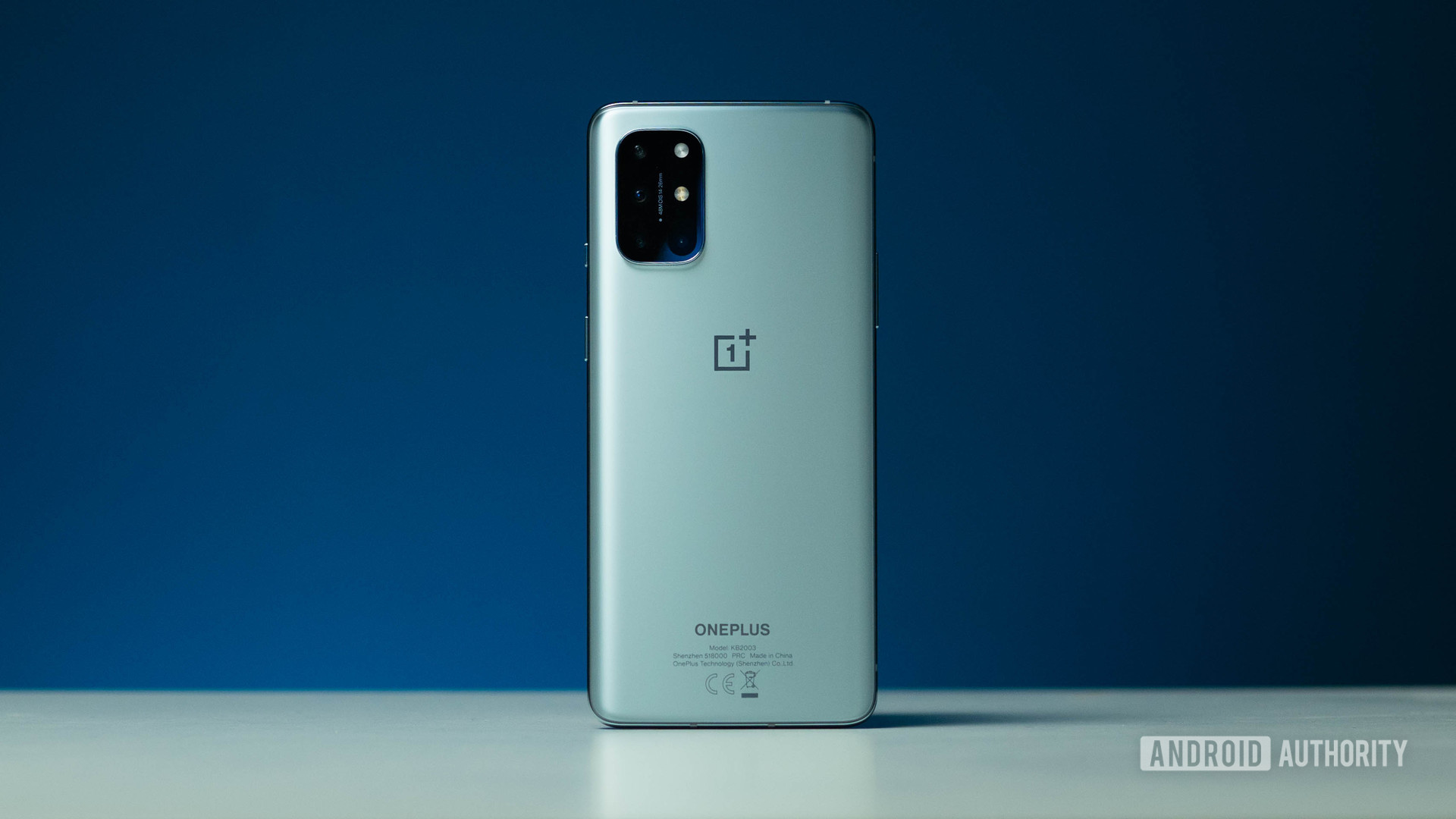
As with the transition from the OnePlus 7 to the OnePlus 7T, the OnePlus 8T features a different design than the OnePlus 8. Most notably, the rear camera module gets a whole new look with a rounded rectangle setup. The front of the phone, though, looks very similar to the OnePlus 8.
The most prominent upgrade with the OnePlus 8T, though, is the introduction of Warp Charge 65. As its name suggests, it offers 65W wired charging speeds. This is twice as fast as any previous OnePlus phone and allows you to charge the 8T from zero to full in just under 40 minutes.
Outside of the fast charging, though, the OnePlus 8T doesn’t feature a whole lot of extensive upgrades as compared to its namesake. It has the same processor, the same RAM/storage configurations, and a very similar camera system (although with an extra monochrome lens thrown in for fun).
Ultimately, the OnePlus 8T was a great phone, but its price tag made it hard to recommend. At $750, it was more expensive than other phones of its class, especially the Samsung Galaxy S20 FE. Since it didn’t have wireless charging or an IP rating, it’s difficult to justify that price when the OnePlus Nord is such a great phone and costs half as much.
OnePlus 8T fast facts:
- The OnePlus 8T launched with Android 11 out of the box, the first global phone to do so (that wasn’t made by Google, of course). It’s currently on Android 12. It’s possible the device could see upgrades through Android 14, although that’s not confirmed.
- The Warp Charge 65 charger that comes with the 8T is powerful enough to charge a laptop. You must use the included USB-C cable to achieve this, though.
- Since the 8T launched with Oxygen OS 11, it’s the first OnePlus device with an always-on display out-of-the-box. This is a long-awaited feature for many OnePlus fans.
- In the United States, you can only get the 12GB/256GB configuration of the OnePlus 8T. There are 8GB/128GB models, but they only landed in certain countries.
- In 2020, the price of the phone started at $750 for the version with 12GB of RAM and 256GB of internal storage.
OnePlus Nord N10 and N100: The cheap entries
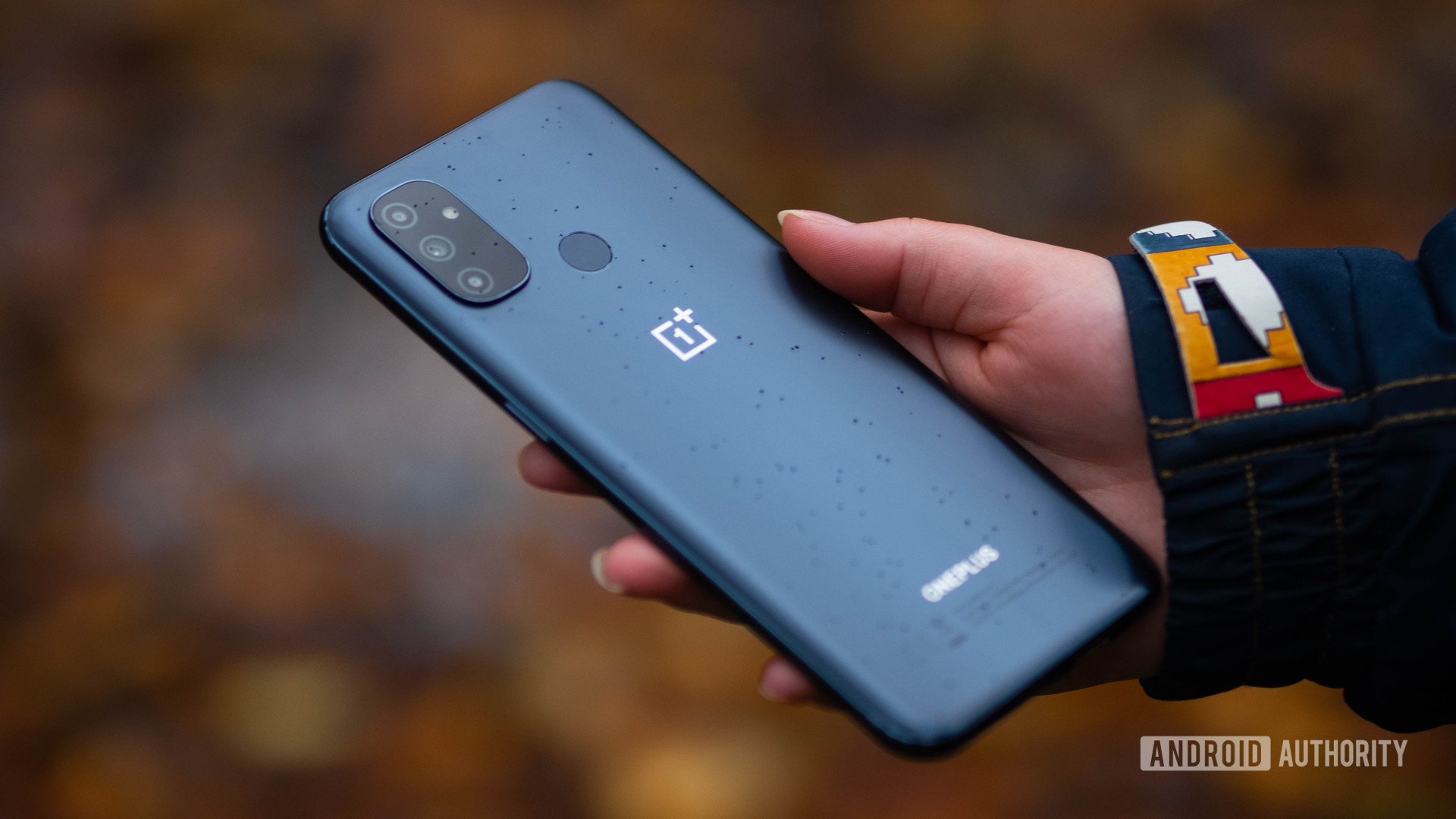
Not long after OnePlus launched the OnePlus 8T, the firm quietly launched two brand new phones: the OnePlus Nord N10 and Nord N100. Both devices are firmly in the budget segment and represent a multitude of “firsts” for the company.
Each device has a weak processor: the Snapdragon 690 for the Nord N10 and the Snapdragon 460 for the N100. These are the lowest-level processors in any OnePlus phone to date. Both phones also feature microSD card slots (something we haven’t seen since the OnePlus X), headphone jacks (which we haven’t seen since the OnePlus 6), and physical fingerprint sensors on the rear (which we also haven’t seen since the OnePlus 6).
With the Nord N10 and N100, OnePlus is clearly gunning for a customer base it has long ignored: budget shoppers. Although the company started as a wallet-friendly brand, even the $300 OnePlus One was more expensive than the N100.
Really, the phones mainly exist to get people who otherwise can’t afford a OnePlus phone into the OnePlus ecosystem.
OnePlus Nord N10 and N100 fast facts:
- The OnePlus Nord N10 and N100 launched with Android 10 out of the box. Even though Android 11 was already available for other OnePlus flagships. OnePlus confirmed that it would ship Android 11 to both phones, but no more Android versions after that.
- The Nord N100 does not support Warp Charge, making it the first OnePlus phone not to support the proprietary charging technology since Dash Charge first launched with the OnePlus 3.
- Neither the Nord N10 nor Nord N100 comes with a hardware alert slider. This is also the first time that’s ever happened since the debut of that feature with the OnePlus 2.
- These two Nord phones are the first in the sub-line to land in the United States.
- In 2020, the price of the N10 started at $300 for the version with 6GB of RAM and 128GB of internal storage, while the N100 started at $179 for the version with 4GB of RAM and 64GB of storage.
OnePlus 9: The balancing act
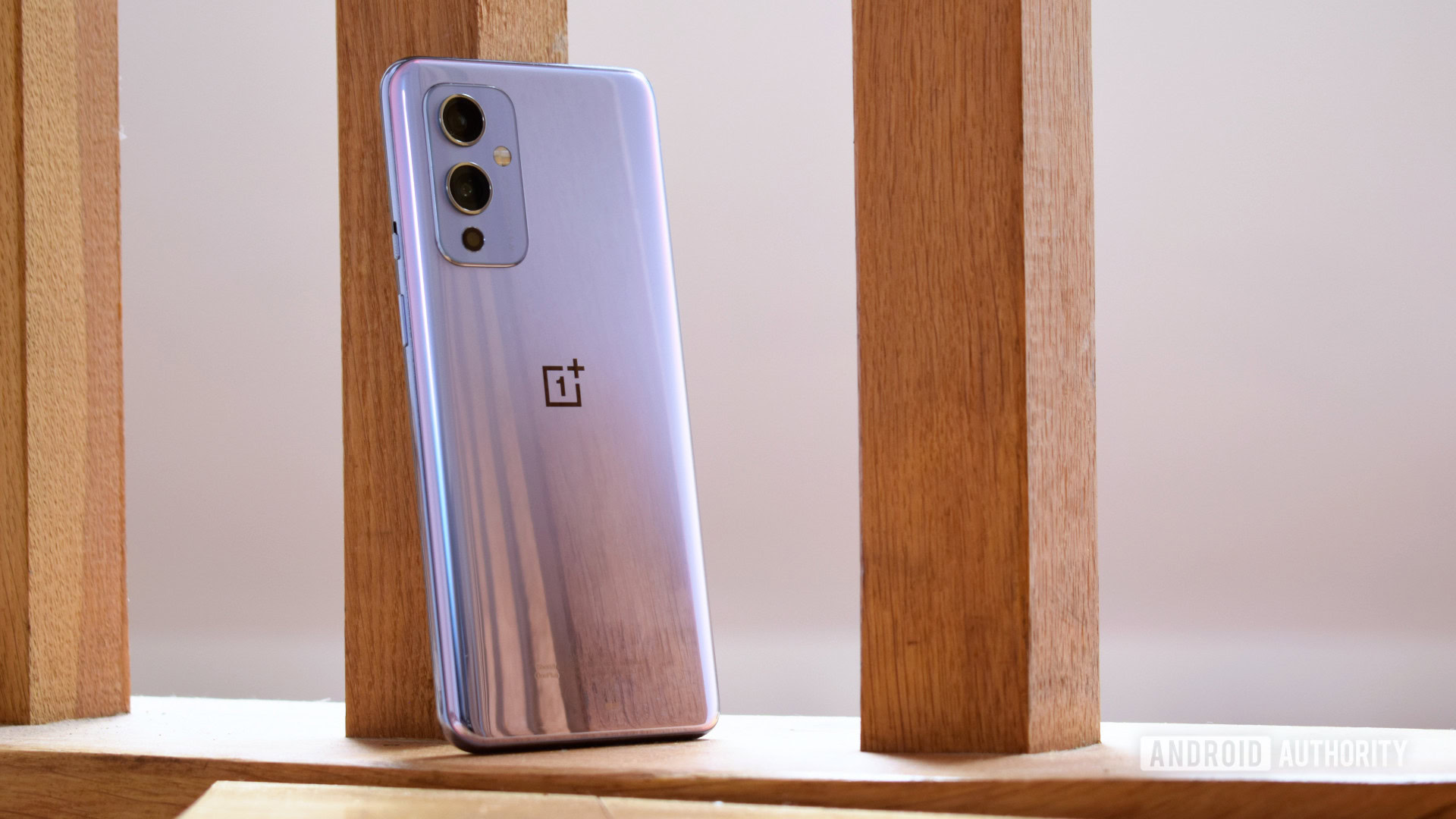
With OnePlus’ introduction of Pro models in 2019, the vanilla models were in a bit of an awkward place. They couldn’t be as good as the Pro models, but they also couldn’t be mid-rangers. These needed to incorporate premium features but still leave out a few to keep the price from ballooning.
The OnePlus 9 is probably the company’s best attempt when it comes to this balancing act. It featured the then latest-and-greatest processor, the Snapdragon 888. It had a solid camera system, good internals, and a price that wasn’t too bad for what you get. Also, for the first time, it offered wireless charging, previously unseen on non-Pro level devices from the brand.
Of course, it was still not a Pro-level phone. For one, there was no telephoto lens, and it also missed out on an IP rating (unless you bought it from T-Mobile in the US). It also didn’t have the build quality of OnePlus’ Pro-level offerings.
Still, the OnePlus 9 was a great option if you wanted as good a phone as possible while paying less than $800. However, its $730 entry price was way more money than we saw even a few years before. Remember that the OnePlus 6 started at $530! New-school OnePlus fans haven’t been too happy with that rising trend.
OnePlus 9 fast facts:
- The OnePlus 9 launched with Android 11 out of the box. It is now on Android 12. OnePlus has promised it will receive three Android upgrades, which means it should eventually get Android 14.
- The OnePlus 9 doesn’t have the fast wireless charging we saw on the OnePlus 8 Pro (or the OnePlus 9 Pro). The vanilla OnePlus 9 is locked at 15W of wireless charging speed.
- Speaking of wireless charging, unfortunately, not everyone gets that perk. OnePlus 9 models sold in India and China do not feature wireless charging for some reason.
- Despite its cheaper price tag, the OnePlus 9 does get the advantages of the Hasselblad partnership (discussed further in the next section). It even has the Hasselblad logo emblazoned on the camera module.
- In 2021, the price of the phone started at $730 for the version with 8GB of RAM and 128GB of internal storage.
OnePlus 9 Pro: The camera phone
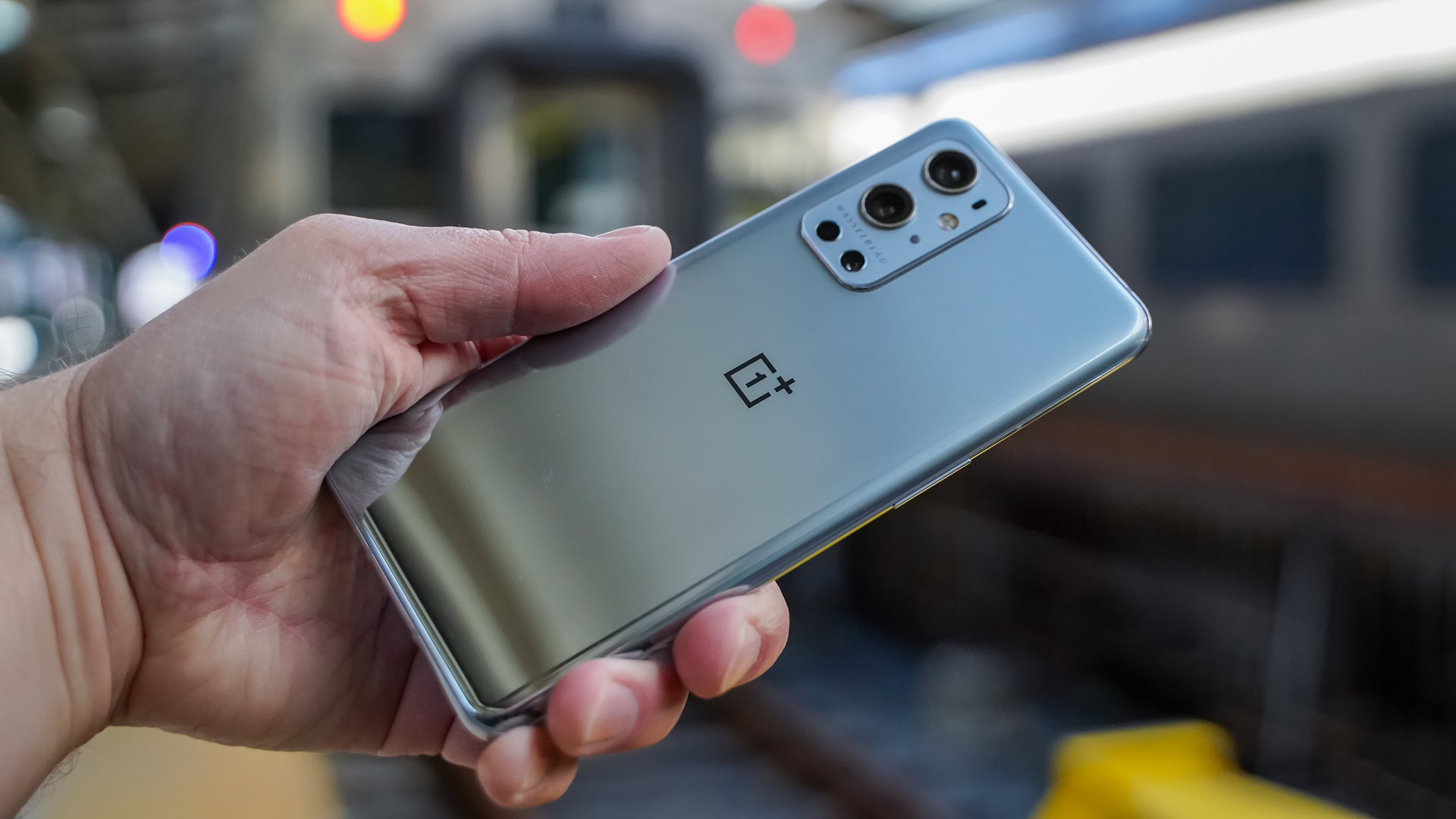
OnePlus has always had a tough time with critics. No matter how much OnePlus tried to make the cameras on its smartphones good, they were never good enough.
That’s a big reason why OnePlus partnered with renowned camera company Hasselblad for the release of the OnePlus 9 series. The partnership — and the camera software that’s the fruit of that partnership — is pretty much all OnePlus is focused on with the OnePlus 9 Pro.
Truth be told, the 9 Pro is among the best camera phones OnePlus has created. Finally, the company could confidently stand among the greats in the photography game, namely Samsung, Google, and Apple.
Of course, there was more to the OnePlus 9 Pro than just its camera chops. It has some blazing-fast wired and wireless charging speeds, an IP rating, a killer display, etc. But the camera is all OnePlus seems to care about here. It’s betting big this phone can kill off its reputation as the underperformer for good.
That Hasselblad partnership couldn’t have been cheap, though. It’s likely a big reason why the starting price for a OnePlus 9 Pro was $970. This made it the most expensive OnePlus of its time.
OnePlus 9 Pro fast facts:
- The OnePlus 9 Pro launched with Android 11 out of the box. It is now on Android 12. OnePlus has promised it will receive three Android upgrades, which means it should eventually get Android 14.
- The OnePlus 8 Pro can charge wirelessly at a speed of 30W, which is fast. The 9 Pro one-ups that by hitting 50W of wireless charging speed. You’ll need a proprietary wireless charging dock to see those speeds, but that’s still insanely fast.
- The Hasselblad partnership, so far, only affects the camera software on the OnePlus 9 and 9 Pro. The camera hardware is still supplied mainly by Sony, just like most other Android flagships. However, there could be custom Hasselblad camera hardware in the future for OnePlus phones.
- The display of the OnePlus 9 Pro is very similar to the one on the Samsung Galaxy S21 Ultra. It has an adaptive refresh rate. It allows it to support rates as high as 120Hz or as low as 1Hz.
- In 2021, the price of the phone started at $970. This is for the version with 8GB of RAM and 128GB of internal storage.
OnePlus Nord CE: Somewhere in between other Nords
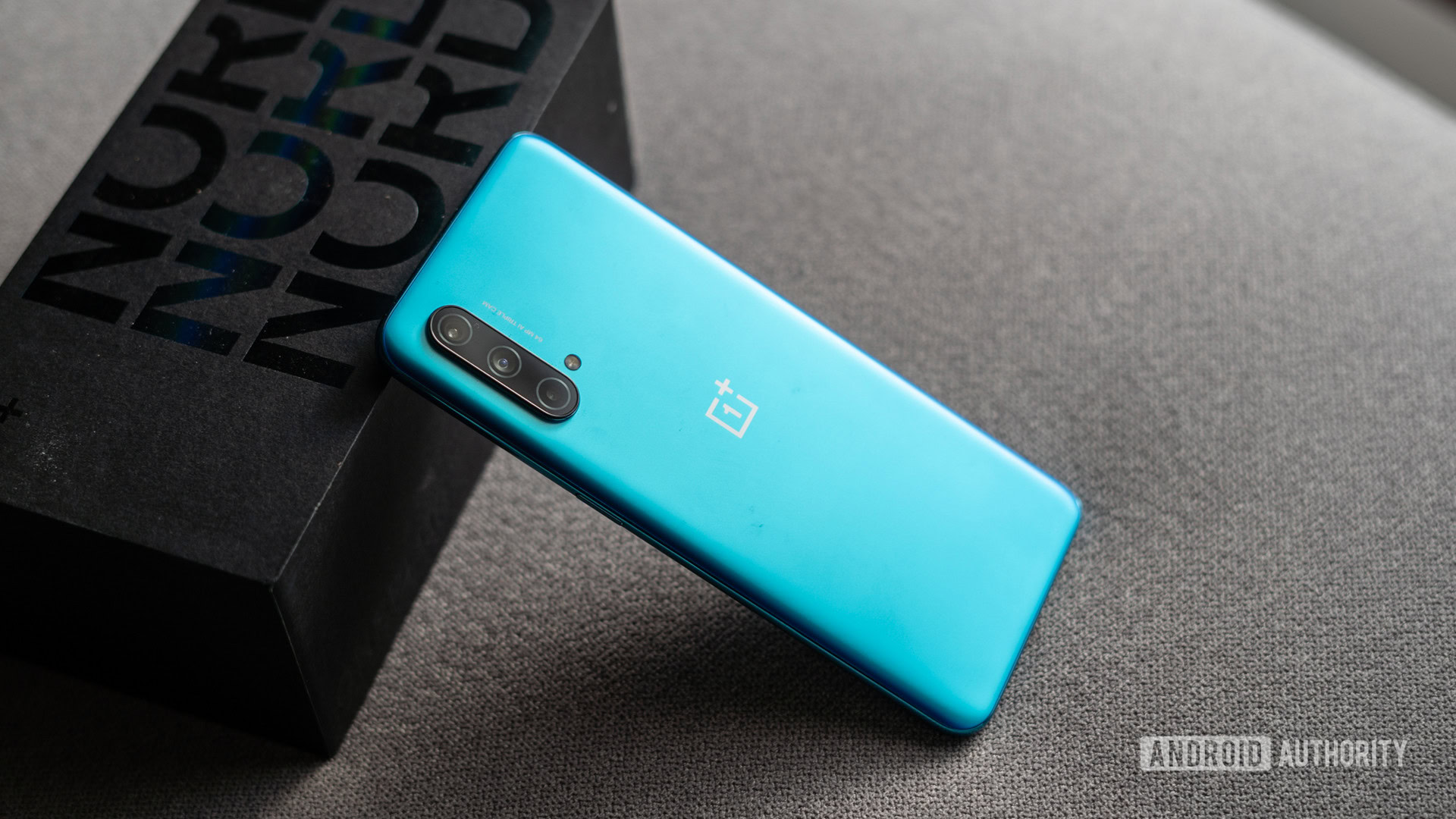
Most of us wondered where the OnePlus Nord CE would fit, as its price point put it somewhere between the Nord and the Nord N100/N10. We weren’t thrilled with the upgrade, as only a bit more money would get you the better OnePlus Nord.
It was a popular phone in India, though, where it was the most affordable available OnePlus handset. However, people in other markets had plenty of inexpensive options that performed much better.
The phone is exceptionally modest in almost every department. The design is very simple. Specs are adequate, but nothing to write home about. You do get fantastic battery life, though, and 30W fast charging.
OnePlus Nord CE fast facts:
- The OnePlus Nord CE launched with Android 11 out of the box. It is now on Android 12. The company promised two years of OS updates and three years of security updates. This means it should get Android 13.
- The price was low, but there were better options for budget devices when it launched. Regardless, it was a great affordable option in the Indian market, where other Nords weren’t available then.
- You get good 30W fast charging.
- In 2021, the phone price started at €300/Rs. 23,000.
OnePlus Nord N200: The ultra-affordable phone is back
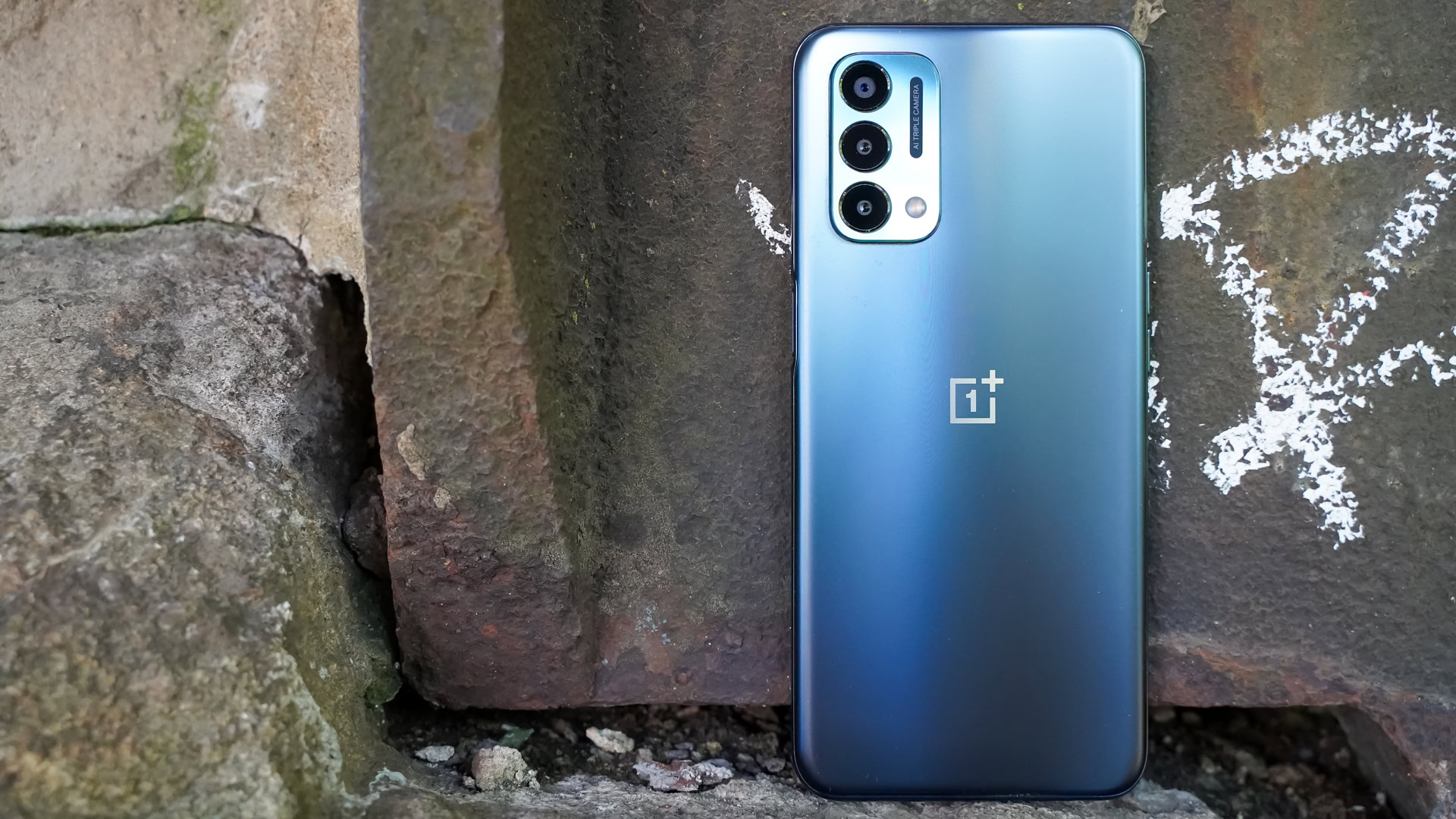
Ultra-affordable smartphones with fair specs are all the hype since 2020. This 2021 OnePlus Nord N200 builds upon the company’s budget lineup as a continuation of the N100. The device came at a great price point ($240). This is a breath of fresh air in a world where smartphones rarely go for less than $400. Even for the budget ones.
While it won’t win any contests, considering its price, the N200 came with fair specs. You get a Snapdragon 480 and 4GB of RAM, as well as 64GB of storage. The design, while mainly composed of plastic, comes with a great feel and texture. Despite having such a low price point, you get high-end specs. These include a 90Hz refresh rate display, as well as a large 5,000mAh battery.
The camera system is pretty basic, comprised of three shooters. The primary camera has a 13MP sensor. You also get a 2MP depth sensor and a 2MP macro.
OnePlus Nord N200 fast facts:
- The OnePlus Nord N200 launched with Android 11 out of the box. It is now on Android 12 and won’t receive any further updates.
- Despite the low price, you get great features. These include a large 6.5-inch 1080p display with a 90Hz refresh rate and a 5,000mAh battery.
- The wired charging speed is capped at 18W and there is no wireless charging available.
- Like its predecessor, the N200 is directly available in the USA.
- In 2021, the price of the phone started at $240, making this one of the most affordable OnePlus devices.
OnePlus Nord 2: The sequelitis
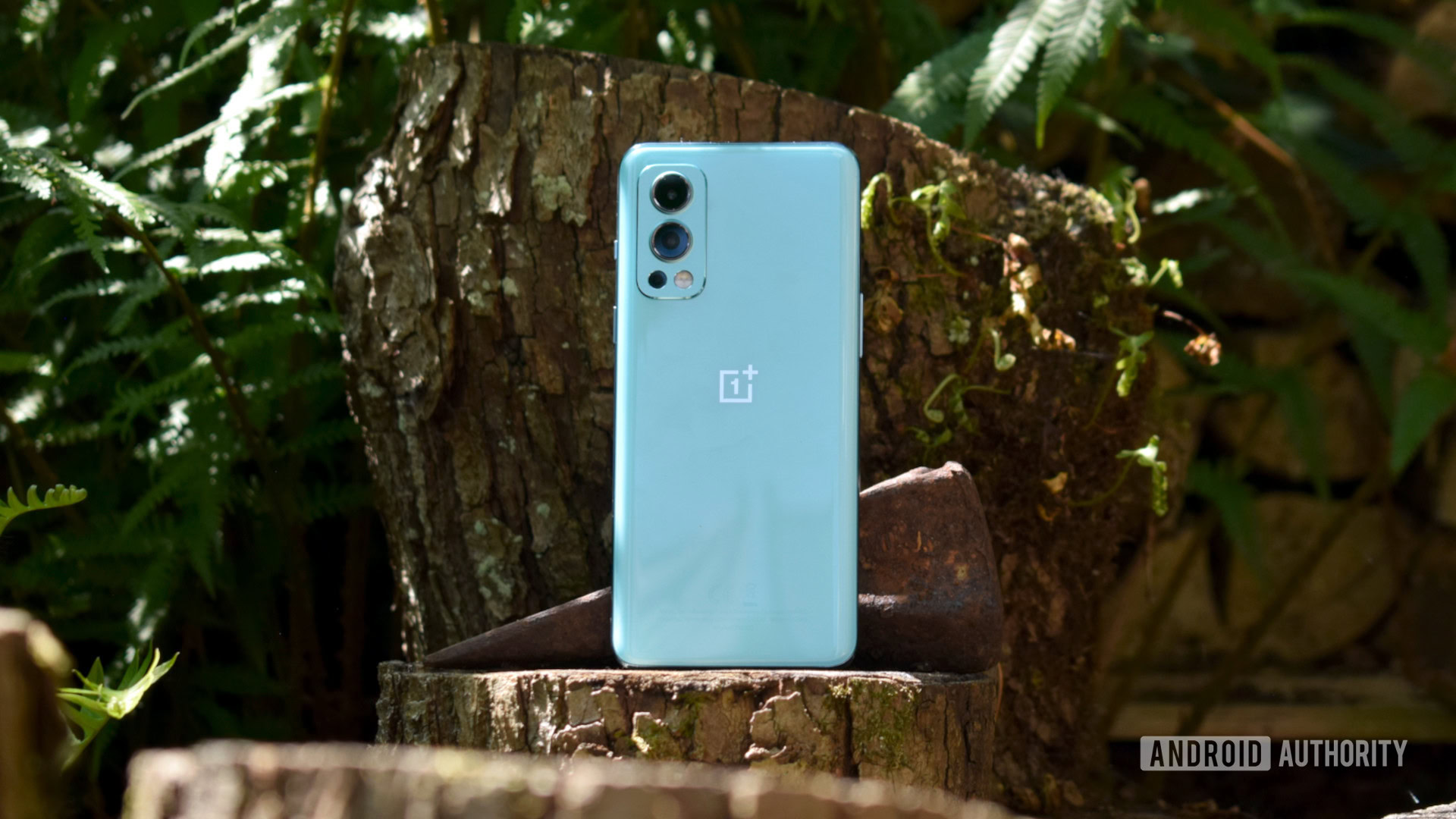
Remember how OnePlus has had problems with its camera systems over the years? It finally solved that problem for its flagships with the OnePlus 9 Pro. However, its mid-range Nord line was still struggling, which is what brought down the OnePlus Nord 2.
Now, the Nord 2 wasn’t a bad phone. It had excellent hardware, an attractive design, and fast 65W wired charging. For its price, it was a pretty good deal. However, it was up against many heavy hitters in the industry. It came up a bit short once you started comparing it to the competition.
Most notably, though, the Nord 2 was the first phone from the brand without a Qualcomm chipset. Instead of a Qualcomm mid-ranger, the Nord 2 had MediaTek’s flagship processor, the Dimensity 1200. This makes the Nord 2 much more potent than its predecessor.
Outside of the processor, though, there wasn’t much about the Nord 2 that you couldn’t get from other phones. It also wasn’t much cheaper than the OnePlus 9R in India, or even the OnePlus 9 with OnePlus’ frequent discounts. As such, be sure to price match the Nord 2 before committing.
OnePlus Nord 2 fast facts:
- The OnePlus Nord 2 launched with Android 11 out of the box. It is now on Android 12. OnePlus has promised it will receive three Android upgrades, which means it should get Android 14.
- There is a model of the OnePlus Nord 2 that comes with 6GB of RAM. However, it is only available in India.
- OnePlus and MediaTek worked together to slightly tweak the Dimensity 1200. As such, the technical name for the processor in this phone is MediaTek Dimensity 1200 AI.
- The selfie sensor, according to OnePlus, is the largest ever from the company. Unfortunately, it only features one lens instead of the two we saw on the original Nord.
- In 2021, the price of the phone started at €420. This was for the version with 8GB of RAM and 128GB of internal storage.
OnePlus 10 Pro: The OPPO phone
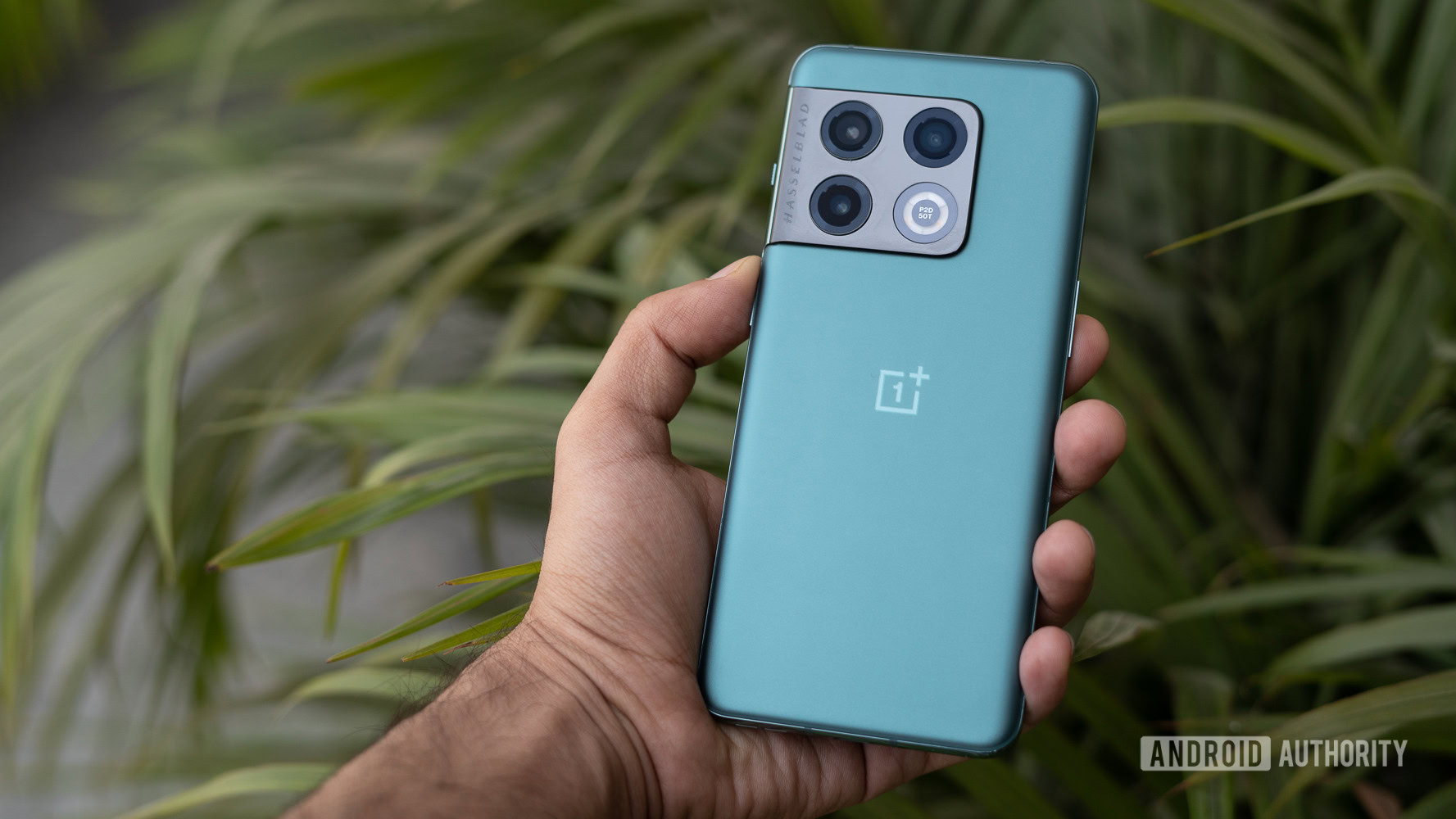
In late 2021, OnePlus announced “OnePlus 2.0.” This marketing jargon was how the company explained its full-on merger with OPPO — you know, the company OnePlus said it had very little to do with from the beginning. Going forward, OnePlus and OPPO now share all resources, with the only exception being each company’s PR team.
With OnePlus and OPPO merged, the companies can crib from each other without hesitation. That’s one of the main reasons why the OnePlus 10 Pro looks a lot like an OPPO phone. It’s also why Oxygen OS 12 — which powers the 10 Pro out-of-the-box — is based on OPPO’s Color OS. It’s also why OnePlus launched the 10 Pro in China first, with no sign of a vanilla OnePlus 10. This is a classic OPPO strategy.
On paper, though, the 10 Pro was a stellar phone. It has a good camera system. It came with the Snapdragon 8 Gen 1 chipset, which is one of the best Android SoCs of 2022. RAM, storage, battery capacity, wired and wireless charging speeds, and all other specs are great.
The phone has also launched globally, and we could get it in North America for $900.
OnePlus 10 Pro fast facts:
- The OnePlus 10 Pro launched with Android 12 out of the box. OnePlus has promised it will receive three Android upgrades, which means it should get Android 15.
- The wired charging speed of the 10 Pro is 80W. This is 15W faster than any other OnePlus phone to date. Sadly, the North American version supports 65W. That’s still very fast, though.
- On the back of the 10 Pro, the ultrawide camera is an older, weaker design than what we saw on the 9 Pro. OnePlus did this to offer a wider field of view.
- Even with other companies abandoning the practice, the 10 Pro still ships with an in-box charger.
- The phone price starts at $899900
OnePlus Nord CE 2: Are OnePlus budget phones improving?
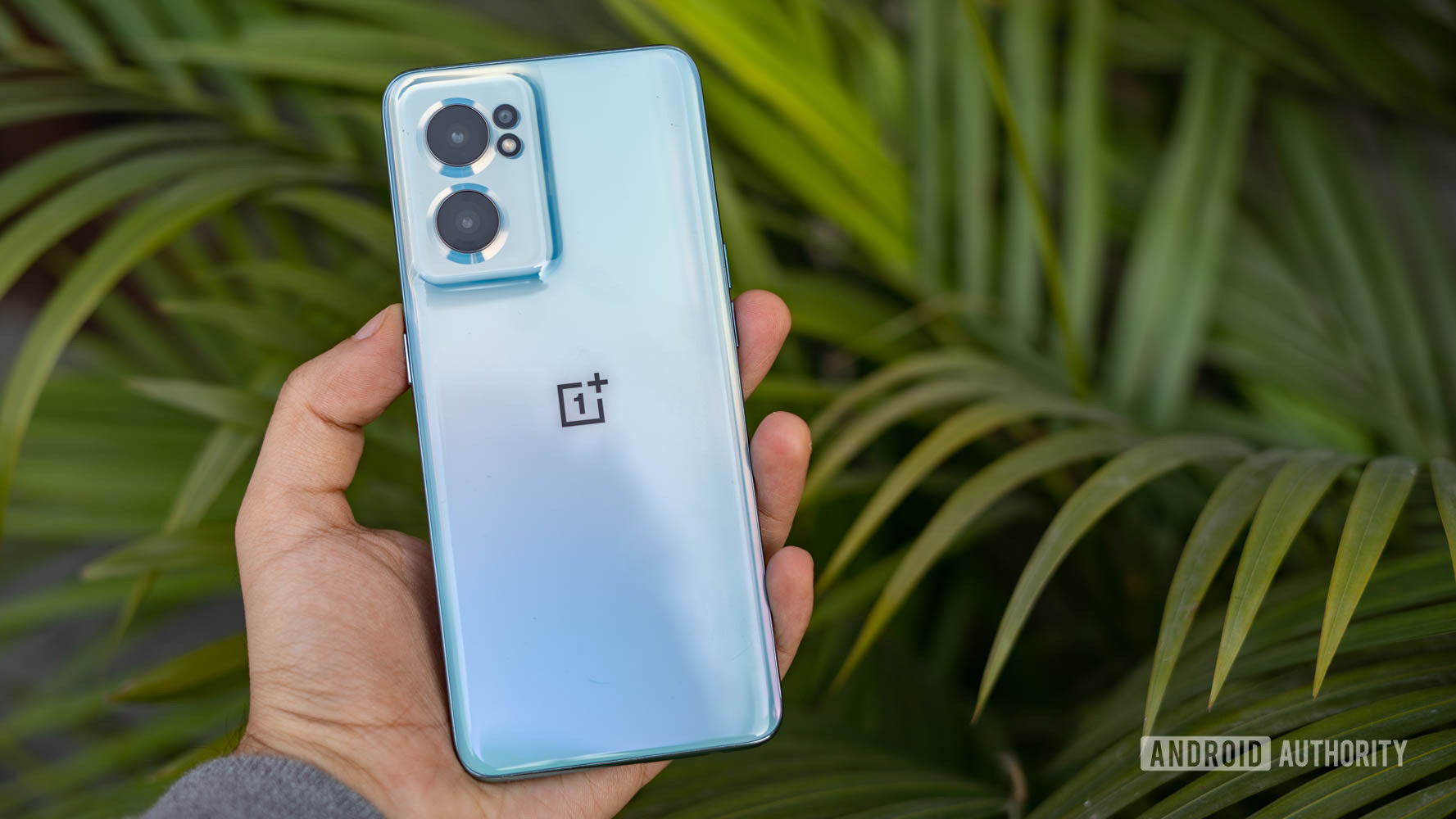
The OnePlus Nord CE did very little to impress us, as it seemed to drown in a world of fantastic budget smartphone options. Sadly, the same seemed to happen with the OnePlus Nord CE 2, but we saw some improvements that made it stand out just a bit more this time around.
For starters, the design is more in line with modern handsets. It actually looks much like the OPPO Reno 7 series, which is a pretty good aesthetic. We’re happier with the performance of the MediaTek Dimensity 900, the primary camera is pretty good, and fast charging is greatly improved, considering the 60W support.
Like 2021’s Nord CE, we still believed there were better options at the OnePlus Nord CE 2’s price range of £300 / €350 / Rs. 25,000.
OnePlus Nord CE 2 fast facts:
- The OnePlus Nord CE 2 launched with Android 11 out of the box. It is now on Android 12. OnePlus has promised it will receive two Android upgrades, which means it should get Android 13. You’ll also get three years of security updates.
- This Nord was made with the collaboration of OPPO, something you can clearly notice in the newer design that is reminiscent of the OPPO Reno 7 series.
- The wired charging speed of the Nord CE 2 is 60W. This makes it twice as fast as its predecessor, the Nord CE.
- The phone’s price starts at £300 / €350 / Rs. 25,000 for the model with 8GB of RAM and 128GB of internal storage. The Indian market gets an option with 6GB of RAM and 128GB of storage for Rs. 24,000.
OnePlus 10T: Missing the mark
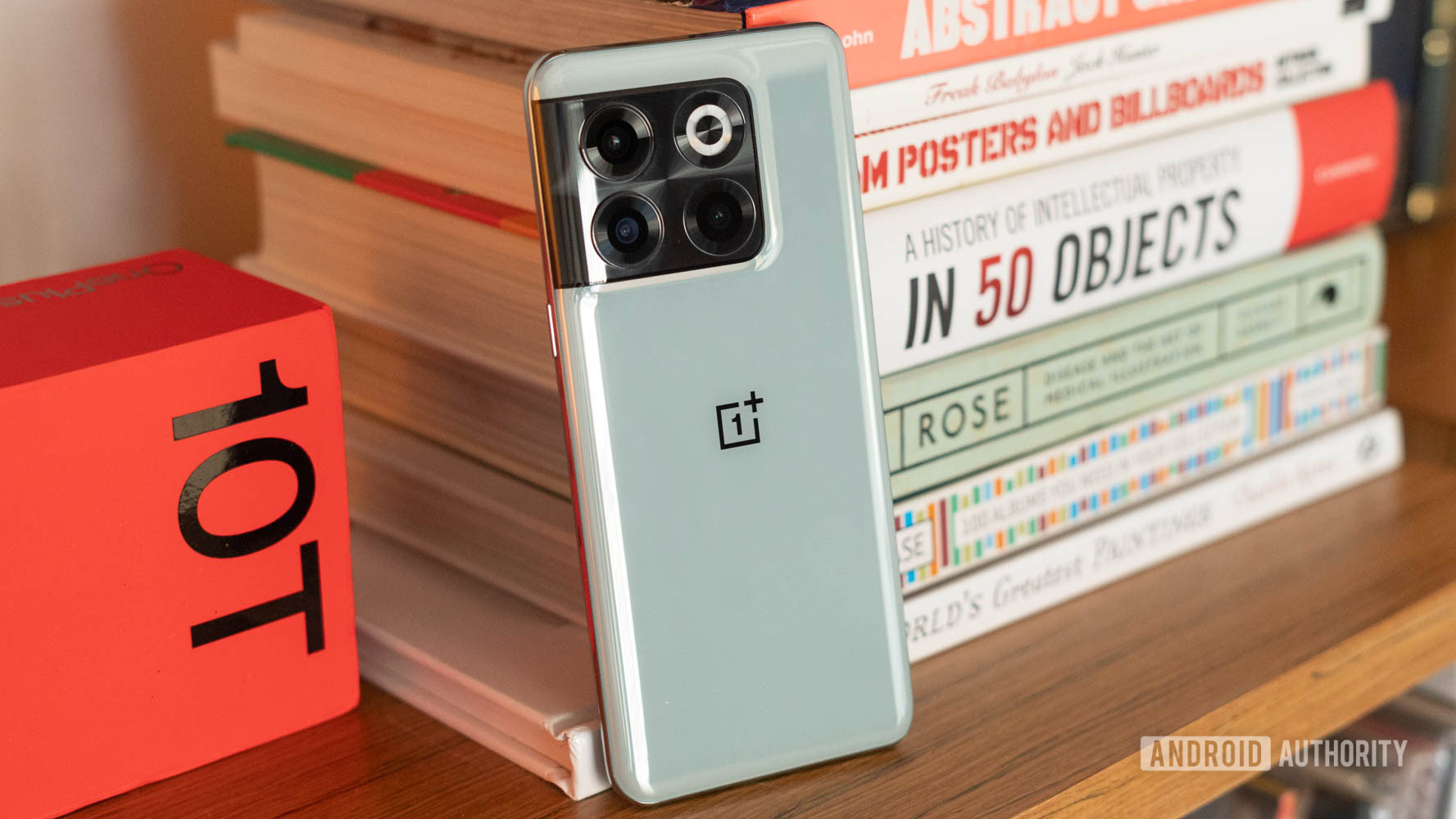
With no OnePlus 10 device, we started to think OnePlus wouldn’t bother with a T-series model in 2022 (after all, there was no T-series flagship in 2021). However, confusingly, OnePlus released the OnePlus 10T in the second half of the year. That means there’s a T-series phone for a phone that doesn’t exist. We know: confusing.
This would be forgivable if the OnePlus 10T was a great phone. However, it was only great if you were looking for two specific things: horsepower and charging speeds. The Snapdragon 8 Plus Gen 1 chipset was a powerhouse that could cut through anything you throw at it, and the ridiculously fast 150W wired charging would take you from zero to 100 in mere minutes. This is still amazingly fast by today’s standards!
However, the camera was a middling mess. There’s no wireless charging. Some models have IP ratings, while others don’t. The phone was just not a good all-rounder and instead was only a niche model for specific buyers.
Thankfully, OnePlus did do a good job on the price. The OnePlus 10T launched at $650, which was decent for a phone of this caliber.
OnePlus 10T fast facts:
- The OnePlus 10T launched with Android 12 out of the box. OnePlus has promised it will receive three Android upgrades, which means it should get Android 15. You’ll also get four years of security updates.
- The 10T’s design is a lot like the 10 Pro’s design, even though the camera systems are quite different.
- In the US, the 10T has an IP54 rating. This means it is water-resistant but not at all waterproof.
- The 10T launched at $650 in the United States.
OnePlus Nord N300: For the few
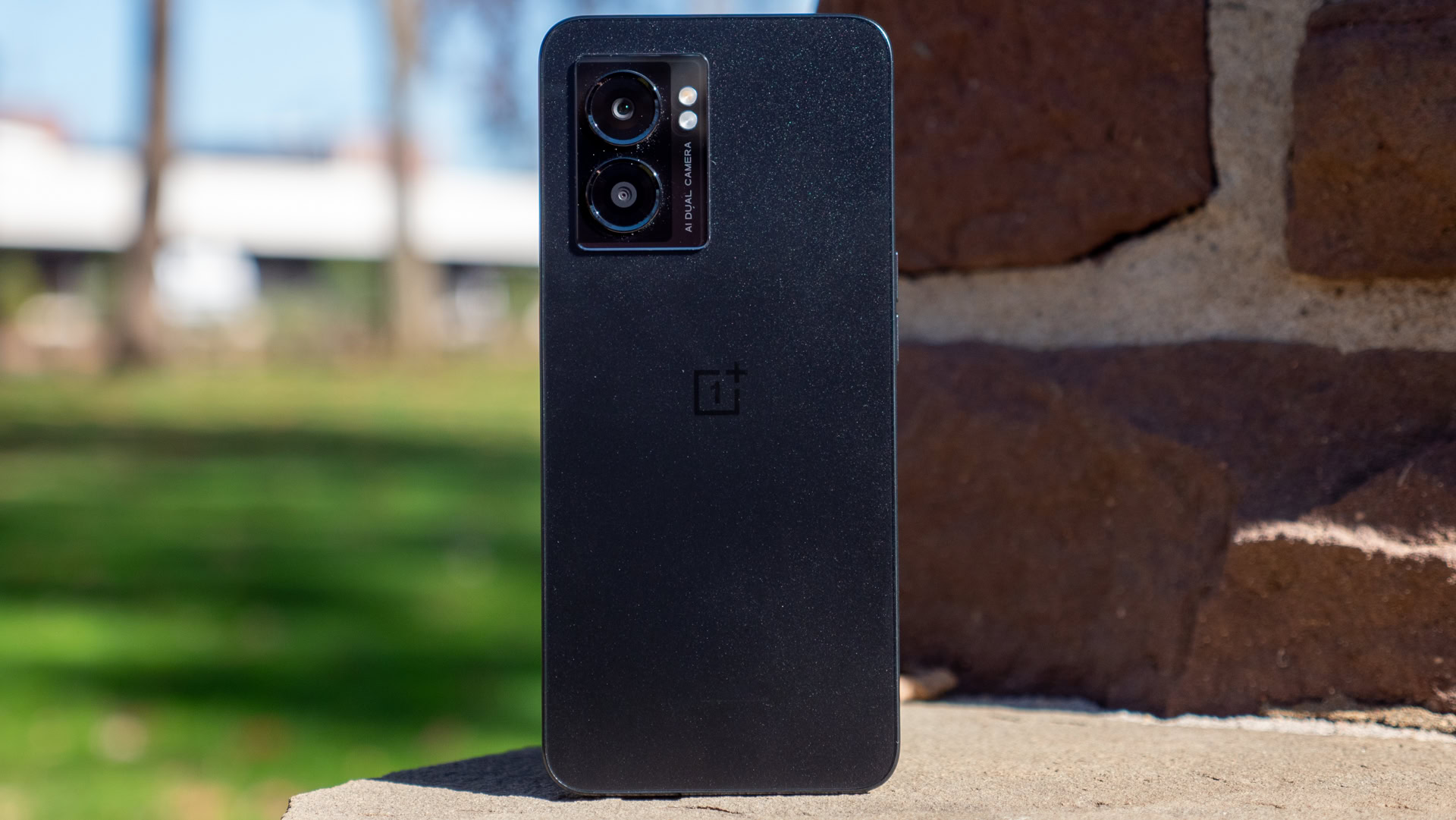
The OnePlus Nord N200 was a good ultra-affordable option for the masses, so we thought the successor would follow in its footsteps. The OnePlus Nord N300 is still a good budget phone at $228, but it has a limited reach thanks to its T-Mobile exclusivity.
If you’re a T-Mobile customer, though, you will enjoy some of its qualities. It still has a headphone jack and expandable storage, which were both very rare features in late 2022, when the Nord N300 was released. It also comes with 33W fast charging, and the 5,000mAh battery will hold a charge for long.
While the design is plasticky, the processor pretty average, OnePlus let us down in its update commitment with this device. One Android update and two years of security patches should be unacceptable when many other manufacturers are committing to more.
The OnePlus N200 was easy to recommend to budget users. The N300? Not so much.
OnePlus Nord N300 fast facts:
- The OnePlus Nord N300 launched with Android 12 out of the box. OnePlus has promised it will receive one Android upgrade, which means it should get Android 13. You’ll also get two years of security updates.
- The Nord N300’s design is actually very unique, even if made of cheaper plastic. It has a boxier look with sharper edges, and the textured back differs in terms of OnePlus aesthetics.
- The Nord N300 has an IP52 rating. This means it is somewhat water-resistant but not at all waterproof. It’s made to handle water sprays.
- The OnePlus Nord has a very low $228 price, but it is only available from T-Mobile.
OnePlus 11: Back to what made OnePlus exciting
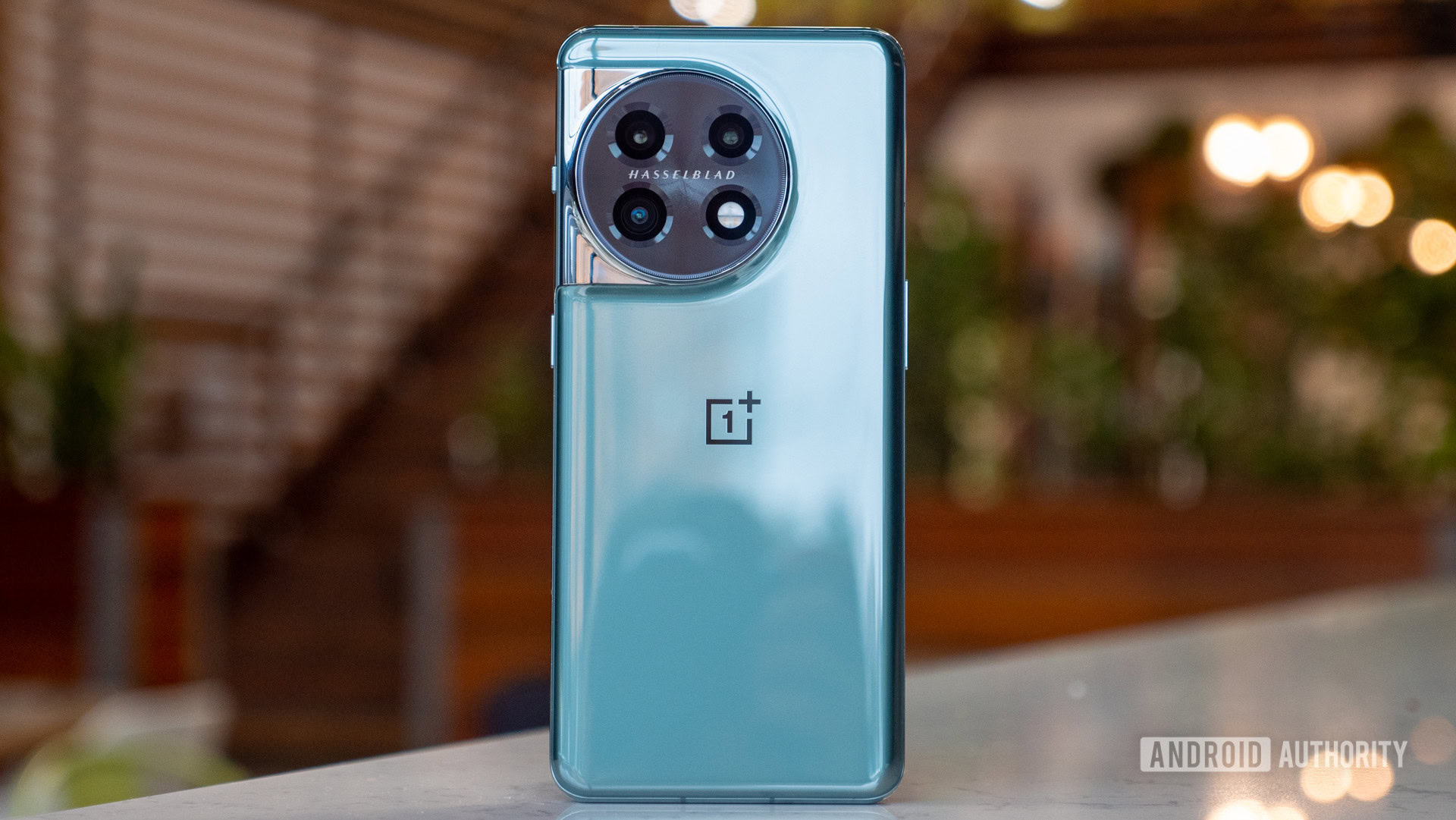
Think back to the first OnePlus phones. These were among the first devices to offer a “budget premium” experience. They used to offer powerful specs, but made some sacrifices in less crucial areas to undercut the competition in pricing. The OnePlus 11 is very similar.
At $700, it undercuts premium offerings from competitors like the Galaxy S23. Regardless, it still comes with a powerful Snapdragon 8 Gen 2 processor, 8-16GB of RAM, as much as 128-512GB of storage, and a sizeable 5,000mAh battery. The 6.7-inch display has a crisp QHD+ resolution, and it sports an LTPO3 Fluid AMOLED panel with a 120Hz refresh rate. Likely the hottest upgrade is its blazing-fast 100W charging speeds, which run circles around the competition. Sadly, US owners will be limited to “just 80W.”
We started this section talking about sacrifices, so let’s get to them. Where are the downsides? OnePlus excluded wireless charging, an essential feature for many of us, in 2023. Additionally, it only comes with an IP64 rating. This is good enough for handling dust, but water resistance is pretty mediocre. It can handle splashes of water instead of more serious protection like submersion.
Sadly, the camera was another department where we got let down. Our OnePlus 11 review highlights that colors are a hit or miss, low-light shots are awful, and zoom capabilities are mediocre.
Of course, the price is excellent, and we know many of you can ignore these downsides to get a high-end experience on a mid-range budget.
OnePlus 11 fast facts:
- The OnePlus 11 launched with Android 13 out of the box. OnePlus has promised it will receive four Android upgrades, which means it should get Android 17. You’ll also get five years of bi-monthly security updates.
- The 11’s design is much like the 10 Pro’s and 10T’s, but the camera bump is circular.
- In the US, the 11 has an IP64 rating. This means it is water-resistant but not at all waterproof.
- The 11’s price starts at $700.
OnePlus Nord N30: Bringing budget phones closer to high-end options
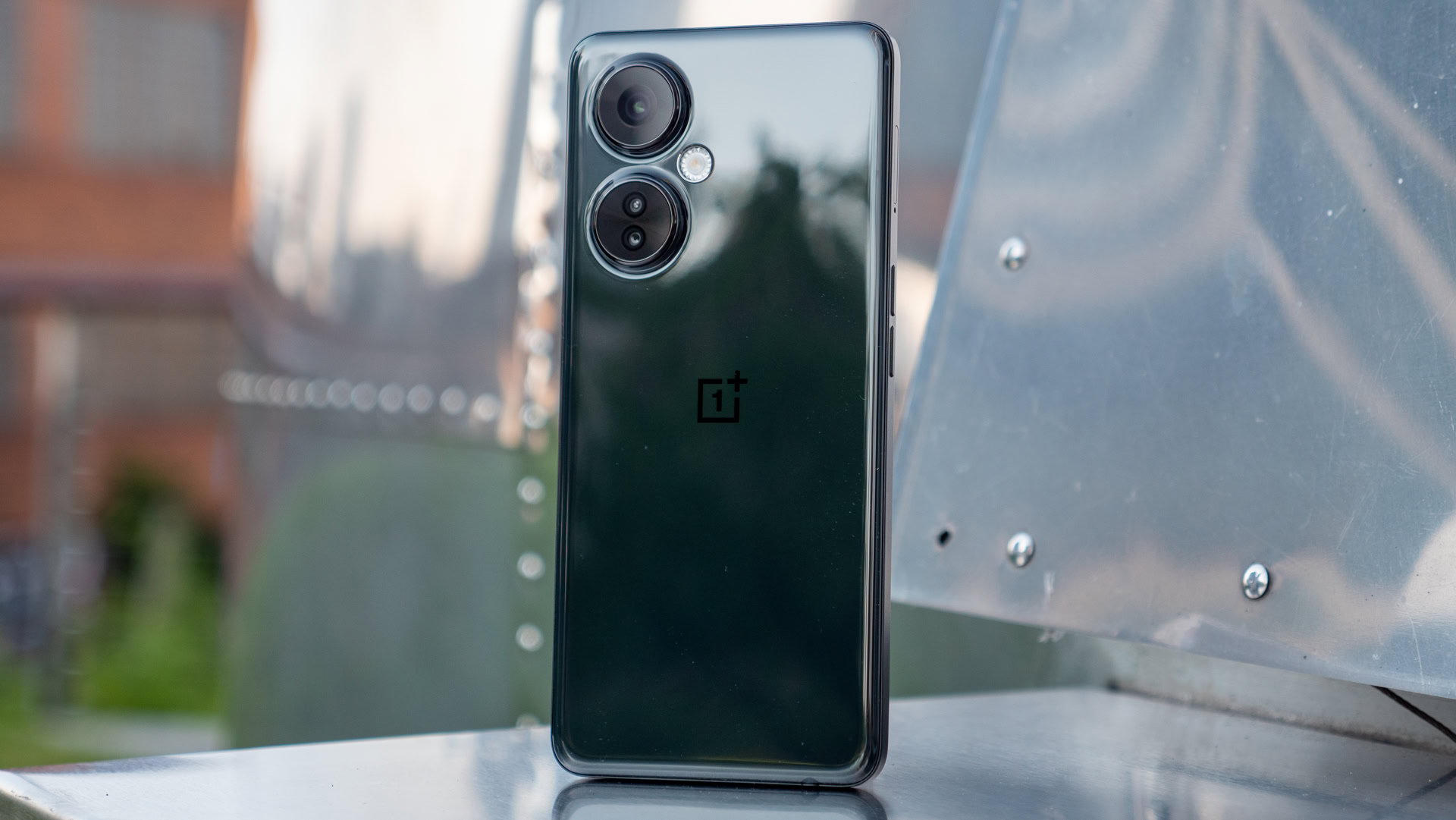
The OnePlus Nord N30 launched right smack in the middle of 2023, and it represents an important shift in technology. It seems modern budget phones are starting to become very powerful. If you took a look at some of these specs, you would think this is a high-end phone, or at least mid-tier. But the price is ultra low at just $300.
Let’s take a look at some of the specs that have us scratching our heads. This phone has a large 6.72-inch screen with a Full HD+ resolution. But get this: the refresh rate is 120Hz, a feature sometimes even expensive phones still can’t get. You also get 8GB of RAM, a nice 108MP primary camera, and fantastic battery life, thanks to the 5,000mAh battery. Not only that, but it has 50W wires charging! That beats many high-end phones like the Samsung Galaxy S23 Ultra, which is stuck at 45W.
Of course, the device has its downsides, including the lack of an IP rating, lackluster secondary cameras, and a bad software update commitment. Still, you are getting much more than what you’re paying.
OnePlus Nord N30 fast facts:
- The OnePlus Nord N30 launched with Android 13 out of the box. OnePlus has promised it will receive one Android upgrade, which means it should get Android 14. You’ll also get three years of security updates.
- The Nord N30 keeps the headphone jack and expandable storage, rare features in 2023. It also comes with a charger in the box!
- The Nord N30 has 50W wired charging, but it lacks wireless charging altogether.
- The Nord N30’s price is $300.
OnePlus Nord 3: Can this budget phone keep up?
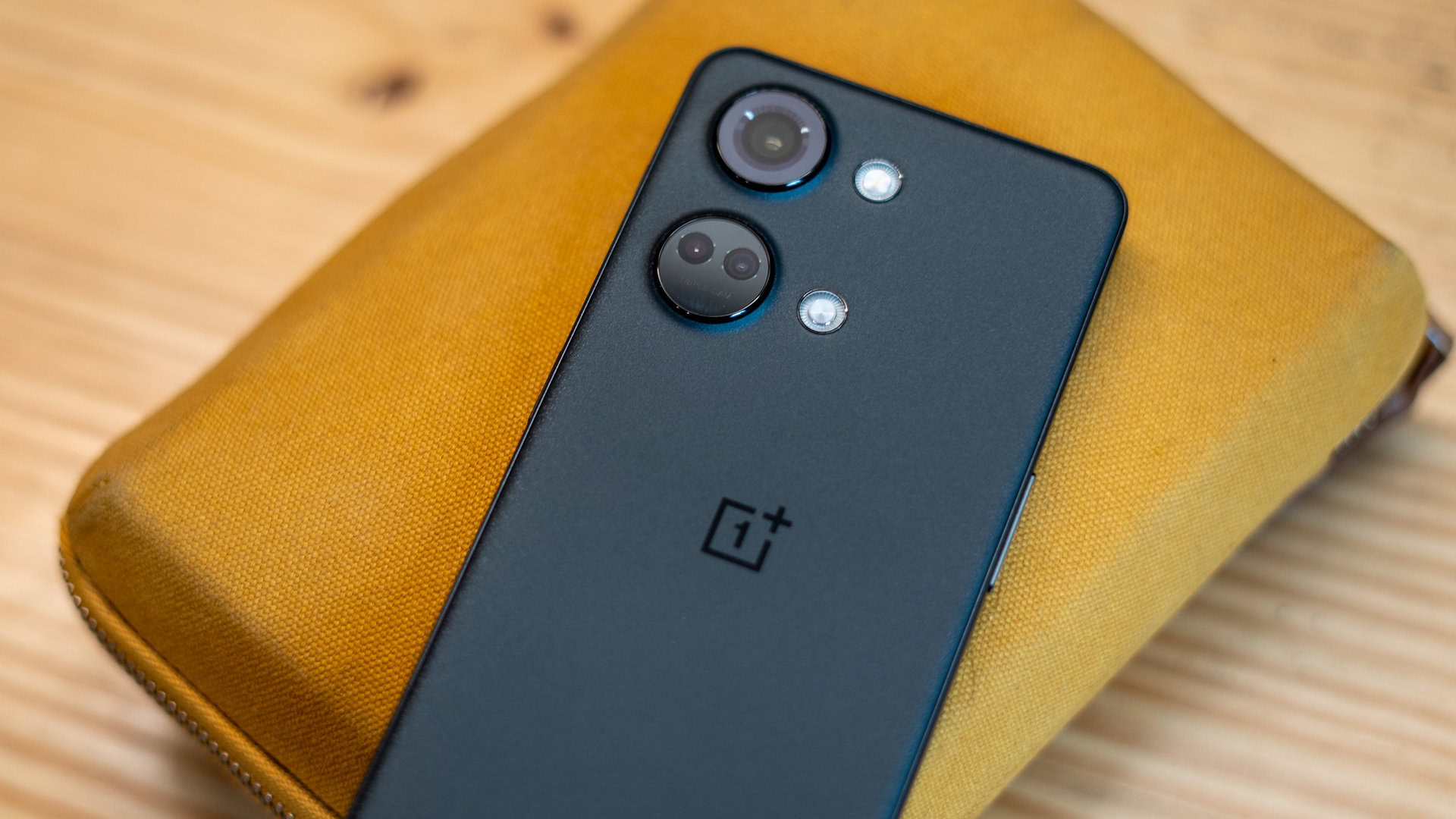
The budget phone market continues to get stronger, and it’s getting harder to differentiate budget phones from flagships. With that said, it’s no surprise the OnePlus Nord has quite a bit of competition. Especially considering its €499 price, which is just in line with other amazing budget phones. Can the Nord 3 keep up?
The OnePlus Nord 3 isn’t that impressive a phone, but it comes with a nice set of features. These include a MediaTek Dimensity 9000, 8-16GB of RAM, and 128-256GB of storage. The Fluid AMOLED screen is pretty nice, as it features a 120Hz refresh rate and a 1,240 x 2,772 resolution. The battery is fairly large at 5,000mAh, and it can charge at up to 80W speeds.
All that said, the phone wasn’t available in the USA, and there are plenty of other great options at this price point now. However, we believe the OnePlus Nord CE 3 Lite may be a better option if you’re looking for something affordable. It costs much less, it looks nearly identical to the Nord 3, and the specs aren’t significantly downgraded.
OnePlus Nord 3 fast facts:
- The OnePlus Nord 3 launched with Android 13 out of the box. OnePlus has promised it will receive three Android upgrades, which means it should get Android 16. You’ll also get four years of security updates.
- The Nord 3 has 80W wired charging, but it lacks wireless charging altogether.
- The Nord 3’s price is €499.
OnePlus Open: The company’s first foldable
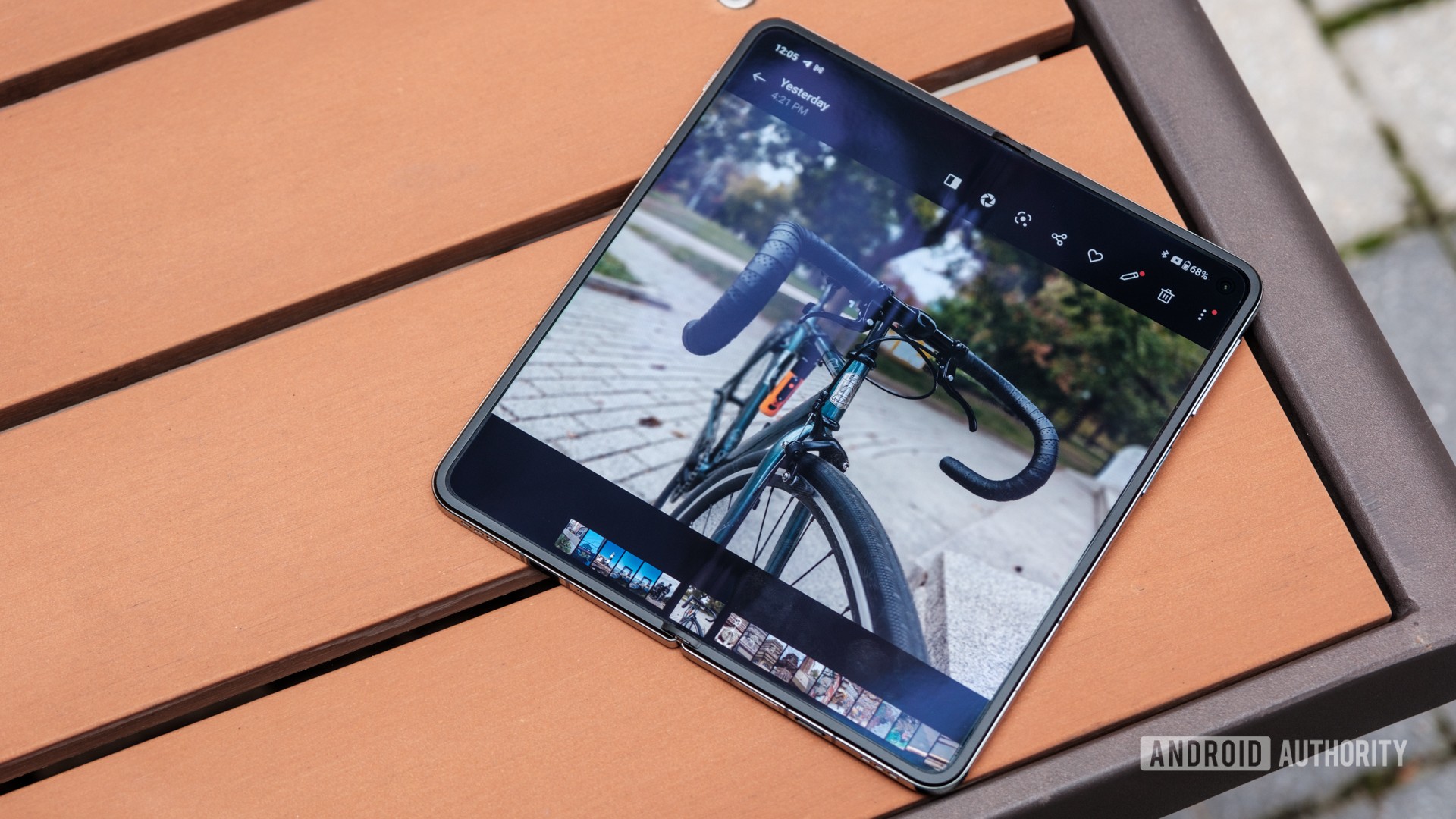
Foldables are all the rage, and smartphone manufacturers are trying to tackle this exciting market with their best efforts. OnePlus actually did quite an amazing job with the OnePlus Open.
In our review, we mention it may actually have the best camera system in any foldable. Additionally, the rest of the experience is nothing short of high-end. It comes with a powerful Snapdragon 8 Gen 2 processor, 16GB of RAM, and 512GB of storage. Both displays are gorgeous, and OnePlus managed to get pretty good battery life out of this phone, which is rare in foldables. Not to mention, charging is pretty fast at 67W.
The device is also a bit cheaper than its closest competitors at $1,700. It does sacrifice wireless charging, though, and it only has an IPX4 rating.
OnePlus Open fast facts:
- The OnePlus Open launched with Android 13 out of the box. OnePlus has promised it will receive four Android upgrades, which means it should get Android 17. You’ll also get five years of security updates.
- The OnePlus Open is a high-end foldable phone through and through. It has great performance, amazing cameras, a gorgeous design, and an overall great experience.
- The Open has 67W wired charging, but it lacks wireless charging altogether.
- The Open’s price is $1,700.
OnePlus 12: Where are the compromises?
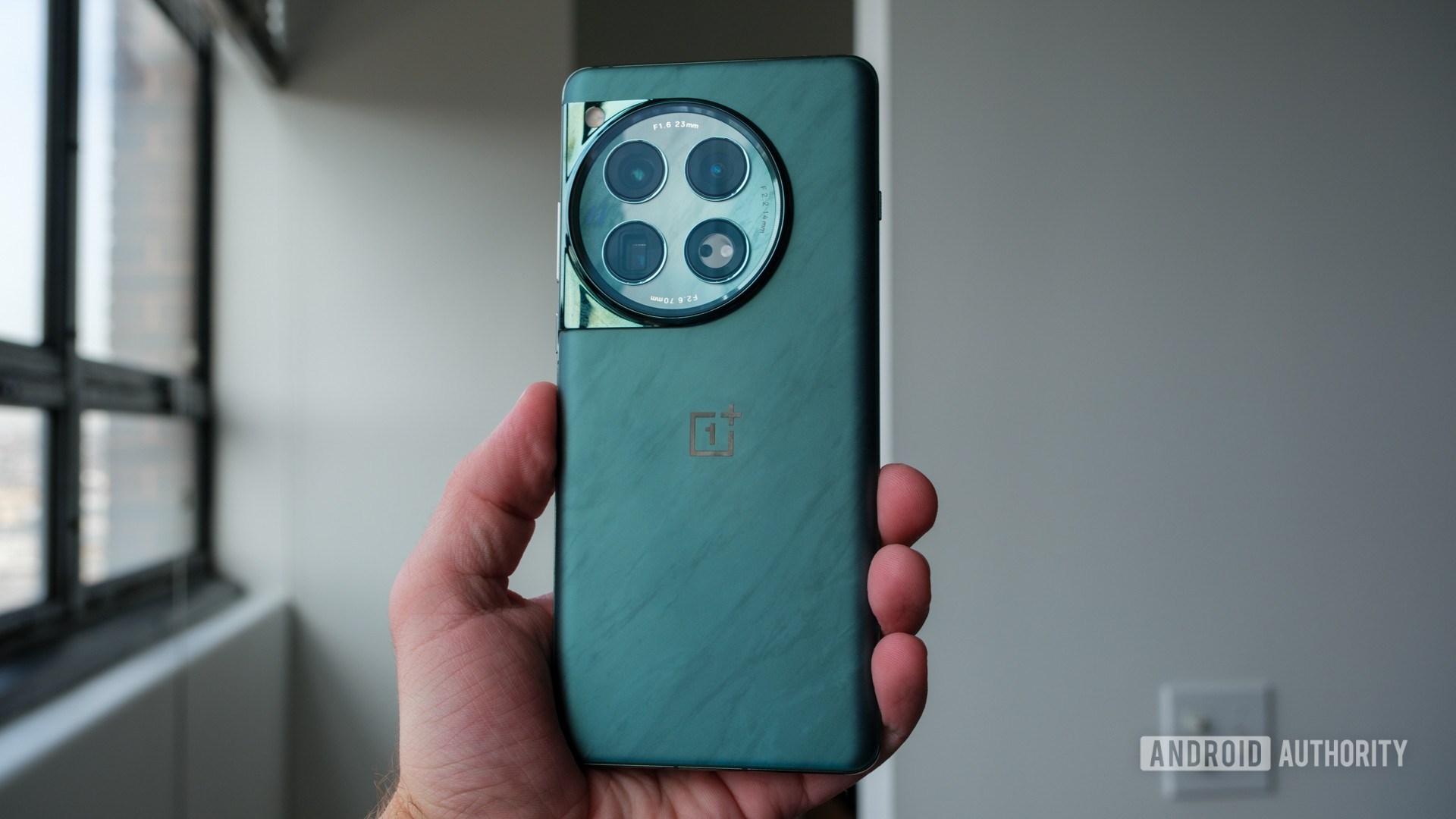
OnePlus was pretty much the original “flagship killer.” While its fame in this department has started to fade, it is still known for making devices that are at least a little cheaper than other flagships, but it has always had to cut some corners to accomplish this. With the OnePlus 12, these lines get blurrier than ever.
While the device is not perfect, it starts at $800 and seems to be nearly as good as competitors above the $1,000 mark. It comes with a powerful Snapdragon 8 Gen 3 processor and 12-24GB of RAM. The 6.82-inch LTPO AMOLED display has a 120Hz refresh rate and a QHD+ resolution. It also has a large 5,400mAh battery is pretty nice, and it charges at up to 100W (or 80W in the USA). Not only does it have wireless charging, but it is also amazingly fast at 50W.
Any downsides? We weren’t fans of the camera, and the IP65 rating is a bit disappointing. Otherwise, OnePlus really hit it out of the park with this one. It seems the company is really polishing its strategy. That said, OnePlus fans feel like the company’s soul is starting to fade. Our own C. Scott Brown is one of them.
OnePlus 12 fast facts:
- The OnePlus 12 launched with Android 14 out of the box. OnePlus has promised it will receive four Android upgrades, which means it should get Android 18. You’ll also get five years of security updates.
- Specs are nothing to scoff at, as the OnePlus 12 comes with a Snapdragon 8 Gen 3 chipset, as much as 24GB of RAM, and a gorgeous LTPO AMOLED screen.
- The OnePlus 12 is one of the leaders in fast charging, both wired and wirelessly. It can charge at up to 100W wired (80W in the USA) or a blazing 50W wirelessly.
- The 12 has an IP64 rating.
- The 12’s starting price is $800.
There you have it, the complete history of OnePlus phones until now! Which one was your all-time favorite?